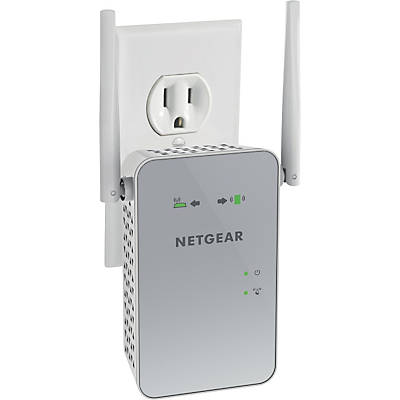 The radio frequency spectrum extends from DC (0hz) to about 3thz (3,000,000,000,000 hz). Anything above that becomes light. The microwave spectrum is anything above 300 mhz. There are numerous types of modulation. Modulation is accomplished by varying one factor of the given wave. (ie frequency, amplitude, etc) Thus the names frequency modulation (FM) and amplitude modulation (AM). Ham radio operators are restricted to certain frequencies and types of modulation. It's possible to create a relay (repeater) system with any frequency and modulation type. You could create one that operated in the FM and band but worked on amplitude modulation. Technically it's against the law but so is what the government is doing.
At some point in the future it might be useful to jam everything but one band of frequency's. (see picture below) Design a noise generator that produces noise over the entire frequency spectrum then filter it for a specific band and put the noise through a mixer circuit along with the data.
The radio frequency spectrum extends from DC (0hz) to about 3thz (3,000,000,000,000 hz). Anything above that becomes light. The microwave spectrum is anything above 300 mhz. There are numerous types of modulation. Modulation is accomplished by varying one factor of the given wave. (ie frequency, amplitude, etc) Thus the names frequency modulation (FM) and amplitude modulation (AM). Ham radio operators are restricted to certain frequencies and types of modulation. It's possible to create a relay (repeater) system with any frequency and modulation type. You could create one that operated in the FM and band but worked on amplitude modulation. Technically it's against the law but so is what the government is doing.
At some point in the future it might be useful to jam everything but one band of frequency's. (see picture below) Design a noise generator that produces noise over the entire frequency spectrum then filter it for a specific band and put the noise through a mixer circuit along with the data.
 Addendum. Today I watched a couple videos about people designing alternative DNS systems. I don’t think this is totally necessary. At least not in small towns. DNS stands for Domain Name Service, or Server ??,. It is a way to route a communication. It’s like an operator in the early days of telephone. Operators sat at a board and physically made the connection to route a call from one place to another. Today it’s done automatically with computers. DNS is the internet equivalent. Lets say you had a small town of about 50,000 people. Everyone’s communications are wireless and handled on one frequency in the microwave range. Everything else was jammed with noise. If someone’s call bounced around the entire town looking for the right end point it wouldn’t take much time and you wouldn’t really notice anything. The frequency is so fast. This is a roundabout example. Anything above 10 hz is not visible to the naked eye. If you pulsed an LED you would see it like it is on all the time once you get it above 10 hz. Any LED monitor or TV has 1000’s of LED that are pulsed many times per second. But it appears to be on all the time. The same effect could be used with voice communications and maybe the internet. Eventually someone might come up with a method to avoid this and save bandwidth and still have no central facility.
Antenna Weave
Did you ever see a picture of the geodesic domes in a NSA spy facility? I think those are antennas. This is what I think is the principle behind their design. Electromagnetic radiation is directional. It depends on how the transmitting antenna is oriented. The electric component is 90 degrees to the magnetic component. (I think) Some Am and FM radios will have an antenna that can be adjusted to maximize the signal. This is why it's adjustable. The geodesic dome allows for the antenna to pick up any radiation in all directions without being adjusted. The geodesic dome was invented by Buckminster Fuller. FYI.
I think it's possible to make a home brew antenna to do the same thing. Get a very long piece of magnet wire. Magnet wire is used in transformers and is designed to pass EMR. (this part I'm not sure is possible) Using one piece of wire weave a mat like a piece of cloth. Stretch the mat into a globe shape. When you're done you will have a very long piece of wire oriented to pick up EMR from any direction. As a rule the longer the antenna the more sensitive it is. A suggestion for the globe would be a beach ball from any dept store. Cover it with plaster of paris and create a sturdy base from wood or metal.
Addendum. Today I watched a couple videos about people designing alternative DNS systems. I don’t think this is totally necessary. At least not in small towns. DNS stands for Domain Name Service, or Server ??,. It is a way to route a communication. It’s like an operator in the early days of telephone. Operators sat at a board and physically made the connection to route a call from one place to another. Today it’s done automatically with computers. DNS is the internet equivalent. Lets say you had a small town of about 50,000 people. Everyone’s communications are wireless and handled on one frequency in the microwave range. Everything else was jammed with noise. If someone’s call bounced around the entire town looking for the right end point it wouldn’t take much time and you wouldn’t really notice anything. The frequency is so fast. This is a roundabout example. Anything above 10 hz is not visible to the naked eye. If you pulsed an LED you would see it like it is on all the time once you get it above 10 hz. Any LED monitor or TV has 1000’s of LED that are pulsed many times per second. But it appears to be on all the time. The same effect could be used with voice communications and maybe the internet. Eventually someone might come up with a method to avoid this and save bandwidth and still have no central facility.
Antenna Weave
Did you ever see a picture of the geodesic domes in a NSA spy facility? I think those are antennas. This is what I think is the principle behind their design. Electromagnetic radiation is directional. It depends on how the transmitting antenna is oriented. The electric component is 90 degrees to the magnetic component. (I think) Some Am and FM radios will have an antenna that can be adjusted to maximize the signal. This is why it's adjustable. The geodesic dome allows for the antenna to pick up any radiation in all directions without being adjusted. The geodesic dome was invented by Buckminster Fuller. FYI.
I think it's possible to make a home brew antenna to do the same thing. Get a very long piece of magnet wire. Magnet wire is used in transformers and is designed to pass EMR. (this part I'm not sure is possible) Using one piece of wire weave a mat like a piece of cloth. Stretch the mat into a globe shape. When you're done you will have a very long piece of wire oriented to pick up EMR from any direction. As a rule the longer the antenna the more sensitive it is. A suggestion for the globe would be a beach ball from any dept store. Cover it with plaster of paris and create a sturdy base from wood or metal.

 EMI Absorbent
Neural implants probably operate on microwaves given the small size. The same with RFID chips. Satellites and mind controlled people are useless if you can't communicate with them. This is the basic premise behind noise generators. If you wanted to help someone you would have to stop the implant or chip from communicating, get them to a facility that is fully protected from surveillance and they might have to stay there a while. EMI shielding could help cut off communication. A tin foil hat will not work because without a connection to earth ground there is no path for current to flow. No Faraday cage will work without a connection to earth ground. Only the reflectivity properties of whatever metal is used will apply. Reflectivity is only a fraction of what the hat encounters. They make EMI absorbent material. It can be bought from any electronic supply house. Mouser.com and Digikey.com for example. 3M makes a wide variety. A 12 inch by 12 inch piece can run about $50. A person could be covered from head to toe with this and brought to a facility that is a Faraday cage. If you don't cover the face, ground based microwave towers could still access the chip. A Faraday cage is an entire building, or enclosure, encased in copper or aluminum and grounded to earth.
EMI Absorbent
Neural implants probably operate on microwaves given the small size. The same with RFID chips. Satellites and mind controlled people are useless if you can't communicate with them. This is the basic premise behind noise generators. If you wanted to help someone you would have to stop the implant or chip from communicating, get them to a facility that is fully protected from surveillance and they might have to stay there a while. EMI shielding could help cut off communication. A tin foil hat will not work because without a connection to earth ground there is no path for current to flow. No Faraday cage will work without a connection to earth ground. Only the reflectivity properties of whatever metal is used will apply. Reflectivity is only a fraction of what the hat encounters. They make EMI absorbent material. It can be bought from any electronic supply house. Mouser.com and Digikey.com for example. 3M makes a wide variety. A 12 inch by 12 inch piece can run about $50. A person could be covered from head to toe with this and brought to a facility that is a Faraday cage. If you don't cover the face, ground based microwave towers could still access the chip. A Faraday cage is an entire building, or enclosure, encased in copper or aluminum and grounded to earth.
 I don't know how EMI absorbent material works. This is 3 ideas of my own. Since the material won't have a connection to ground for current my ideas try to generate current within the material itself. The first idea (top picture) would involve spinning microscopic wires into a material that has a small resistance to current flow. The wires would still have a small amount of insulation on them. They would be spun into small coils. The ends of the coils would be bare so as to make contact with the resistive material and make thousands of microscopic circuits as shown in the drawing. Each circuit would develop current and absorb the EMI.
I don't know how EMI absorbent material works. This is 3 ideas of my own. Since the material won't have a connection to ground for current my ideas try to generate current within the material itself. The first idea (top picture) would involve spinning microscopic wires into a material that has a small resistance to current flow. The wires would still have a small amount of insulation on them. They would be spun into small coils. The ends of the coils would be bare so as to make contact with the resistive material and make thousands of microscopic circuits as shown in the drawing. Each circuit would develop current and absorb the EMI.
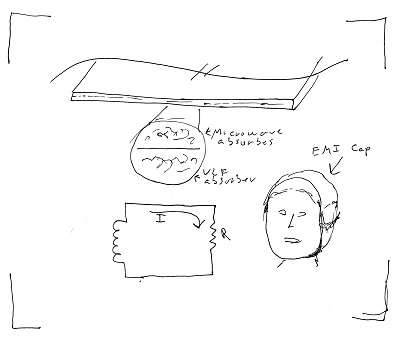 A home brew version might be possible if you bend ordinary 1/4 or 1/8 watt resistors as shown in the next picture and then lay them out on some sort of substrate.
A home brew version might be possible if you bend ordinary 1/4 or 1/8 watt resistors as shown in the next picture and then lay them out on some sort of substrate.
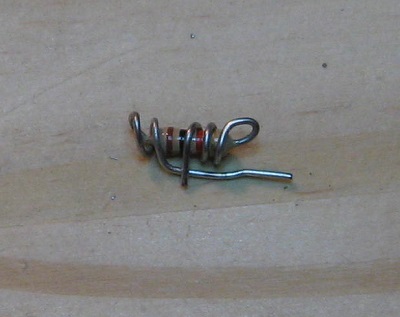
 A more complicated version could be made by weaving wires together. It might require building some kind of manufacturing equipment or maybe an ordinary loom could be used. I think you could look up patents in the patent office online on how screen for windows and doors is made and copy that. The idea is to make screen that is half nylon and half aluminum. All the nylon would go one way, either horizontal or vertical, and the aluminum the other way. Every 6 inches or so connect a resistor across 2 of the aluminum strands. Keep each pair of aluminum strands separate from each other. The patent office could be used for all kinds of ways to fight back.
A more complicated version could be made by weaving wires together. It might require building some kind of manufacturing equipment or maybe an ordinary loom could be used. I think you could look up patents in the patent office online on how screen for windows and doors is made and copy that. The idea is to make screen that is half nylon and half aluminum. All the nylon would go one way, either horizontal or vertical, and the aluminum the other way. Every 6 inches or so connect a resistor across 2 of the aluminum strands. Keep each pair of aluminum strands separate from each other. The patent office could be used for all kinds of ways to fight back.
 This is an addendum to the EMI absorbent material idea. Along with the mat of woven circuits put a layer of aluminum foil on each side. Aluminum has the best reflective properties of any metal. This will help trap EMI inside the mat. It will also reduce the power that needs to be consumed by reflecting a portion before it gets to the circuits. In addition to the coils and resistors in the circuits you could add an IC that helps to jam whatever is being absorbed. It works the same as an RFID. It's powered by the EMI.
This is an addendum to the EMI absorbent material idea. Along with the mat of woven circuits put a layer of aluminum foil on each side. Aluminum has the best reflective properties of any metal. This will help trap EMI inside the mat. It will also reduce the power that needs to be consumed by reflecting a portion before it gets to the circuits. In addition to the coils and resistors in the circuits you could add an IC that helps to jam whatever is being absorbed. It works the same as an RFID. It's powered by the EMI.
 Faraday Cage
A Faraday cage is an enclosure, room or entire building (like the NSA building at Ft Meade), encased in metal and then grounded to earth. It prevents electromagnetic waves from entering or leaving. It works the same as a coax cable (see picture) If the braided shielding is grounded to earth the conducting core is protected from noise coming from the outside. The NSA building is copper, but aluminum has the best reflective property’s of any metal. Aluminum flashing can be bought at any construction supply (Home Depot, Lowes). Attach it to one side of some plywood panels and place the panels on the floor of the attic. Somehow ground it to earth. There are companies that sell and install metal roofs. This might defeat satellite surveillance but not cell phone towers. If a satellite can pick up EMI at 10,000 miles cell phone towers can do the same. Cell phone systems are on the ground and would be capable of snooping through the walls not the roof. To defeat this, the whole house would have to covered with aluminum. They used to sell aluminum siding, I don’t know if they still do.
Faraday Cage
A Faraday cage is an enclosure, room or entire building (like the NSA building at Ft Meade), encased in metal and then grounded to earth. It prevents electromagnetic waves from entering or leaving. It works the same as a coax cable (see picture) If the braided shielding is grounded to earth the conducting core is protected from noise coming from the outside. The NSA building is copper, but aluminum has the best reflective property’s of any metal. Aluminum flashing can be bought at any construction supply (Home Depot, Lowes). Attach it to one side of some plywood panels and place the panels on the floor of the attic. Somehow ground it to earth. There are companies that sell and install metal roofs. This might defeat satellite surveillance but not cell phone towers. If a satellite can pick up EMI at 10,000 miles cell phone towers can do the same. Cell phone systems are on the ground and would be capable of snooping through the walls not the roof. To defeat this, the whole house would have to covered with aluminum. They used to sell aluminum siding, I don’t know if they still do.
 A Faraday cage can protect from radiated intrusion, both transmitted and received, but it doesn’t help with conducted surveillance. Any wire entering or leaving a building and connected to a utility (electric, cable, phone) is a highway for someone to snoop. Any house has thousands of feet of wire. A large building has miles and it can all be used for transferring data. Broadband Over Powerlines (BPL) is a technology that uses the AC wiring in a building for delivering the same data as the coax cable. Telephone wiring could also be used without a person’s knowledge. It used to be that when a device was off it was off. But now almost everything plugged in is drawing current even when not in use. I used to think this was done just to pad the electric bill but it may also have a more sinister purpose. Anything plugged into a wall outlet in your house could be snooping. The wiring itself could be a problem. As a rule the bigger the antenna, the more sensitive it is. So the wiring in your house could be a very sensitive antenna capable of picking up your personal emissions. There are at least 2 ways to defeat some of these problems. Filtering and injecting noise onto the wires.
Some basic filtering solutions are snap on beads and inline filters. (see below) A snap on bead is a ferrite that can be placed on any wire to suppress high speed signals. Inline filters can be bought at home improvement stores and can be placed in series to filter out unwanted frequencies. The third picture is a filter that can be added to home built electronics.
A Faraday cage can protect from radiated intrusion, both transmitted and received, but it doesn’t help with conducted surveillance. Any wire entering or leaving a building and connected to a utility (electric, cable, phone) is a highway for someone to snoop. Any house has thousands of feet of wire. A large building has miles and it can all be used for transferring data. Broadband Over Powerlines (BPL) is a technology that uses the AC wiring in a building for delivering the same data as the coax cable. Telephone wiring could also be used without a person’s knowledge. It used to be that when a device was off it was off. But now almost everything plugged in is drawing current even when not in use. I used to think this was done just to pad the electric bill but it may also have a more sinister purpose. Anything plugged into a wall outlet in your house could be snooping. The wiring itself could be a problem. As a rule the bigger the antenna, the more sensitive it is. So the wiring in your house could be a very sensitive antenna capable of picking up your personal emissions. There are at least 2 ways to defeat some of these problems. Filtering and injecting noise onto the wires.
Some basic filtering solutions are snap on beads and inline filters. (see below) A snap on bead is a ferrite that can be placed on any wire to suppress high speed signals. Inline filters can be bought at home improvement stores and can be placed in series to filter out unwanted frequencies. The third picture is a filter that can be added to home built electronics.
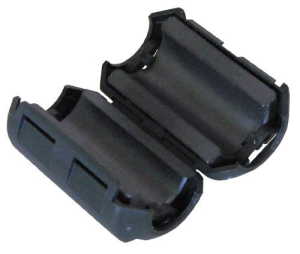

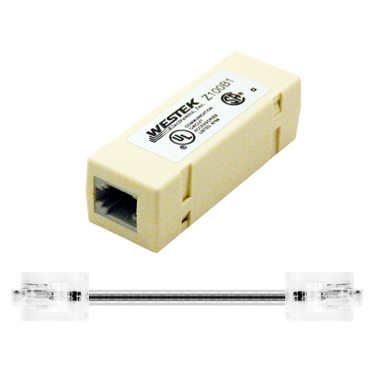
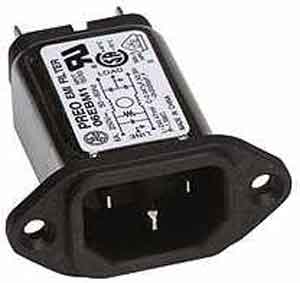 Injecting noise onto AC wiring is basically the same concept as Broadband Over Powerlines. (BOP). It is possible to get a higher frequency signal to 'ride' on a lower frequency signal. X10 technology was invented in the 1980's. X10 uses AC wiring to control lights and other devices inside a home. The same technology could be used to put noise on the AC wiring.
Injecting noise onto AC wiring is basically the same concept as Broadband Over Powerlines. (BOP). It is possible to get a higher frequency signal to 'ride' on a lower frequency signal. X10 technology was invented in the 1980's. X10 uses AC wiring to control lights and other devices inside a home. The same technology could be used to put noise on the AC wiring.
 To prevent the AC wiring from picking up your emissions like an antenna you could place all the wiring in conduit or Romex conduit and ground it to earth. I know this makes no sense if your house has already been built but I'm just making a point. It's the same thing as coax cable. The conduit acts like a Faraday Cage and keeps noise from leaving the AC wiring or anything getting onto the wiring. Injecting noise onto the wiring is an alternative if you can't rewire everything. They make shielded AC wire but it's expensive.
To prevent the AC wiring from picking up your emissions like an antenna you could place all the wiring in conduit or Romex conduit and ground it to earth. I know this makes no sense if your house has already been built but I'm just making a point. It's the same thing as coax cable. The conduit acts like a Faraday Cage and keeps noise from leaving the AC wiring or anything getting onto the wiring. Injecting noise onto the wiring is an alternative if you can't rewire everything. They make shielded AC wire but it's expensive.
 I think it makes sense to both inject noise onto the wiring and filter it at the same time. Any device plugged in could be conducting surveillance. It could be using the AC wiring to communicate with the outside world. Generating noise inside the house could stop the device from picking anything up and injecting it onto the AC wiring can defeat it's transfer to the outside. Filtering at the same time can make sure.
Sidenote. Some people believe the HAARP facility in Alaska is used in mind control and surveillance. It's stated mission is communicating with submarines on Extremely Low Frequencies. (0 HZ to 100 HZ) In fact they think it operates around 30 HZ. It is possible to get high speed data to 'ride' on the 30 HZ. The 30 HZ might be powering the RFID chips and carrying the communication data.
High Wattage Pulse Generator
Purpose - To disable in place neural implants and/or RFID chips placed under the scalp by
destroying micro-miniature electronic components with a high wattage pulse of
electromagnetic energy directed at the head. This process is in addition to TASERing
someone in the head or using ECT (electro convulsive therapy) or breaking an RFID chip
with a hammer.
Theory of Operation - The horn antenna is placed very near the head of the person with the implant or RFID chip. The device runs on ordinary household 120 AC from a wall outlet. The 120 AC is stepped up by a step-up transformer. That voltage is fed to a full wave bridge rectifier and then made into DC voltage by regulating capacitor and resistor. When switch 1 is thrown point-A immediately goes to maximum DC since capacitor is a dead short to DC voltage. Capacitor then charges to maximum DC voltage and point-A goes to zero voltage. The time for point-A to go from zero voltage to maximum voltage and back is determined by the equation T=RC. Since a high surge of current is desired, using a small value resistor makes for a very quick and powerful pulse of energy. If maximum DC voltage were 1000 volts a surge of 3000 Watts could be made with a resistor of 333 Ohms. A time of 1/2 a second could be made with a
1.5mF capacitor. High wattage components for this application might be hard to find, but
they do make capacitors for AC motors that are commercially available. They could be
bought at grainger.com.
I think it makes sense to both inject noise onto the wiring and filter it at the same time. Any device plugged in could be conducting surveillance. It could be using the AC wiring to communicate with the outside world. Generating noise inside the house could stop the device from picking anything up and injecting it onto the AC wiring can defeat it's transfer to the outside. Filtering at the same time can make sure.
Sidenote. Some people believe the HAARP facility in Alaska is used in mind control and surveillance. It's stated mission is communicating with submarines on Extremely Low Frequencies. (0 HZ to 100 HZ) In fact they think it operates around 30 HZ. It is possible to get high speed data to 'ride' on the 30 HZ. The 30 HZ might be powering the RFID chips and carrying the communication data.
High Wattage Pulse Generator
Purpose - To disable in place neural implants and/or RFID chips placed under the scalp by
destroying micro-miniature electronic components with a high wattage pulse of
electromagnetic energy directed at the head. This process is in addition to TASERing
someone in the head or using ECT (electro convulsive therapy) or breaking an RFID chip
with a hammer.
Theory of Operation - The horn antenna is placed very near the head of the person with the implant or RFID chip. The device runs on ordinary household 120 AC from a wall outlet. The 120 AC is stepped up by a step-up transformer. That voltage is fed to a full wave bridge rectifier and then made into DC voltage by regulating capacitor and resistor. When switch 1 is thrown point-A immediately goes to maximum DC since capacitor is a dead short to DC voltage. Capacitor then charges to maximum DC voltage and point-A goes to zero voltage. The time for point-A to go from zero voltage to maximum voltage and back is determined by the equation T=RC. Since a high surge of current is desired, using a small value resistor makes for a very quick and powerful pulse of energy. If maximum DC voltage were 1000 volts a surge of 3000 Watts could be made with a resistor of 333 Ohms. A time of 1/2 a second could be made with a
1.5mF capacitor. High wattage components for this application might be hard to find, but
they do make capacitors for AC motors that are commercially available. They could be
bought at grainger.com.

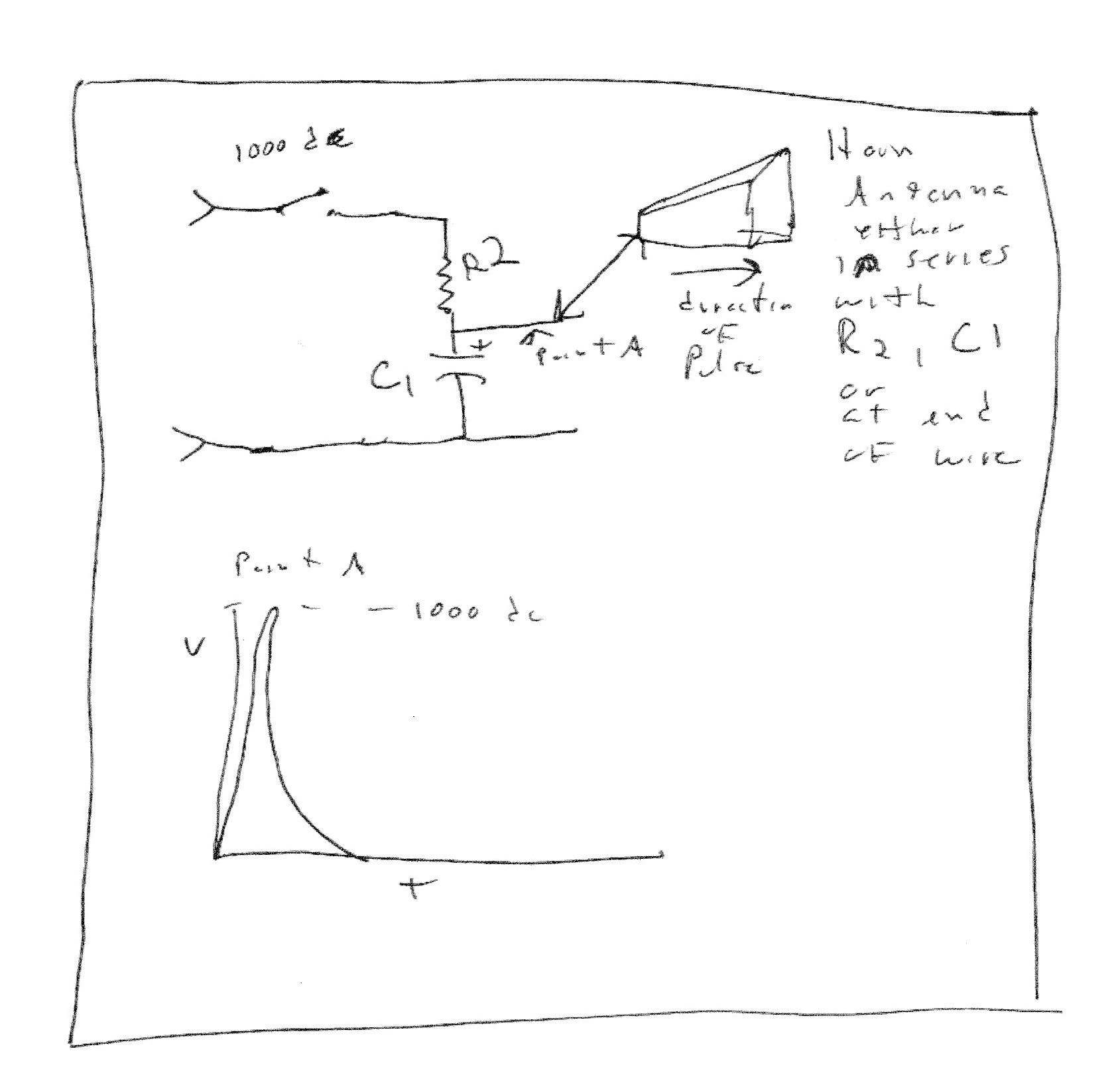 Problems - The schematic is over simplified. I am just trying to pass on an idea. A massive surge of current would probably draw down the DC voltage and seriously reduce wattage. A high power regulator would be needed. The capacitor would need to be discharged after each use to reset.
Addendum - This is an attempt to fix some of the issues brought up in the 'Problems' section above. The original design will pull down the DC voltage as the pulse rises. The overall wattage will be affected. This design adds an array of super-capacitors as a power source for the pulse. Super-capacitors are designed to hold a large amount of energy at high ratings such a 3500 volts. The definition of a capacitor is that it stores energy in an electric field. It can act something like a battery. It can be charged then discharged. The idea is to replace the AC supply and regulator with a an array of super capacitors. The capacitors are charged through a resistor. When the capacitors are fully charged an indicator circuit lights. The resistor and AC supply circuit can then be removed by throwing a switch. When ready, another switch is thrown to discharge the capacitors into the antenna circuit. After discharge the antenna circuit is switched out and the capacitors charged again.
Problems - The schematic is over simplified. I am just trying to pass on an idea. A massive surge of current would probably draw down the DC voltage and seriously reduce wattage. A high power regulator would be needed. The capacitor would need to be discharged after each use to reset.
Addendum - This is an attempt to fix some of the issues brought up in the 'Problems' section above. The original design will pull down the DC voltage as the pulse rises. The overall wattage will be affected. This design adds an array of super-capacitors as a power source for the pulse. Super-capacitors are designed to hold a large amount of energy at high ratings such a 3500 volts. The definition of a capacitor is that it stores energy in an electric field. It can act something like a battery. It can be charged then discharged. The idea is to replace the AC supply and regulator with a an array of super capacitors. The capacitors are charged through a resistor. When the capacitors are fully charged an indicator circuit lights. The resistor and AC supply circuit can then be removed by throwing a switch. When ready, another switch is thrown to discharge the capacitors into the antenna circuit. After discharge the antenna circuit is switched out and the capacitors charged again.
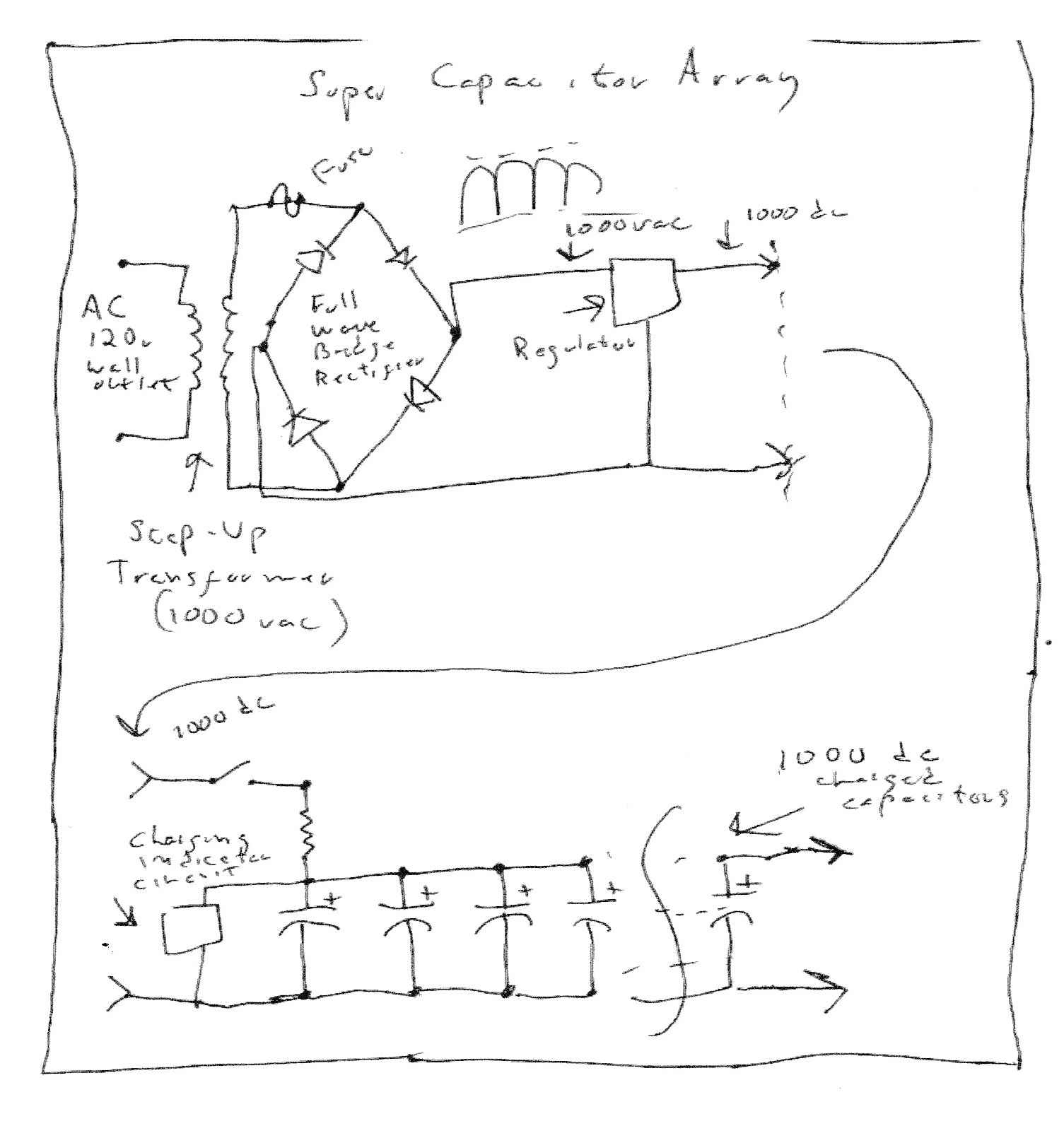 Note: Everything today runs on software. Even X-ray and MRI machines. If you took someone to a hospital or doctors office and had an X-ray or MRI it’s very possible that the software removed the implant from the result. I would do it again somewhere you know this won’t happen.
This is an idea for a mechanical/chemical high wattage pulse generator. (see drawings) Technically this would act like an AC battery and there is no such thing. But whatever. To produce electro-magnetic waves you must move the electrons in the piece of copper. The entire assembly would comprise 2 main parts. The first would be a large copper plate with a large piece of copper extending from the plate to act as an antenna and the second, an aluminum container with multiple compartments. (or glass with the top being aluminum) The compartments would hold the containers with the chemicals and valves. The chemicals would be discharged by a detonator into a mixing compartment. The mixing compartment would have a valve that pulses the mixture into the top compartment to stimulate the copper. The third compartment would initially be in a vacuum to pull the mixed chemicals from the top compartment as they are pulsed in. A separate valve between the top compartment and the vacuum would keep the pulses separate. The power and frequency could be controlled with the pressure of the chemicals and the rotation of the valves. A pulsing valve could be accomplished by using a fan in a cage with only a couple holes for air to pass and only one fan in the cage. Every time the holes line up, a pulse of chemicals enters the top compartment.
Note: Everything today runs on software. Even X-ray and MRI machines. If you took someone to a hospital or doctors office and had an X-ray or MRI it’s very possible that the software removed the implant from the result. I would do it again somewhere you know this won’t happen.
This is an idea for a mechanical/chemical high wattage pulse generator. (see drawings) Technically this would act like an AC battery and there is no such thing. But whatever. To produce electro-magnetic waves you must move the electrons in the piece of copper. The entire assembly would comprise 2 main parts. The first would be a large copper plate with a large piece of copper extending from the plate to act as an antenna and the second, an aluminum container with multiple compartments. (or glass with the top being aluminum) The compartments would hold the containers with the chemicals and valves. The chemicals would be discharged by a detonator into a mixing compartment. The mixing compartment would have a valve that pulses the mixture into the top compartment to stimulate the copper. The third compartment would initially be in a vacuum to pull the mixed chemicals from the top compartment as they are pulsed in. A separate valve between the top compartment and the vacuum would keep the pulses separate. The power and frequency could be controlled with the pressure of the chemicals and the rotation of the valves. A pulsing valve could be accomplished by using a fan in a cage with only a couple holes for air to pass and only one fan in the cage. Every time the holes line up, a pulse of chemicals enters the top compartment.

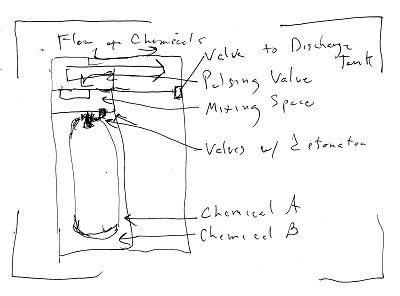
 This is some of the theory behind it. Electric current is the actual movement of electrons in a conductive substance. Usually metal. The electrons move from one nucleus to another in a random fashion. A term for these electrons is valence electrons. The more valence electrons a substance has the more conductive it is. Electrons are negatively charged. A nucleus of an atom has both protons and neutrons, which are positively charged and electrically neutral respectively. As the electrons move they create electro-magnetic waves around the conductor. If the waves are varying in nature they can be picked up by a AC clamp meter. A clamp meter is basically a transformer that surrounds the conductor to measure its strength. It only works with AC waves, not DC. I don't know why. In electricity similar polarities repel each other and opposite polarities attract. The idea behind a battery is there is a buildup of electrons on one side and a depletion on the other. If you attach a circuit between current will flow. The battery dies when the electrons on one side have all drifted to the positive. In our universe gasses can be ionized. That is they can have a too many electrons or too few. Or they can be neutral. The PH of water is a measurement of it's ionization. The idea is to find a gas that can be heavily laden with electrons to make it negatively charged. That gas would be pulsed into a glass chamber where the copper plate is. When the copper plate is exposed to the highly charged gas it moves the electrons in the copper because similar polarities repel. If the gas is pulsed you will create a varying wave.
If you wanted to make some serious trouble with this idea you could mount it inside a truck and attach it to an aluminum frame. The frame would act as the antenna. Drive by a building (NSA) and blow it off and you might destroy whats inside.
Automobile companies won’t build electric cars because battery technology is too expensive and doesn’t hold enough energy to run a car very long. (or so they say) Have they looked into alternative methods for generating alternating current?
I downloaded both images below from ‘Google Images’ by typing in ‘neuro radio’.
This is some of the theory behind it. Electric current is the actual movement of electrons in a conductive substance. Usually metal. The electrons move from one nucleus to another in a random fashion. A term for these electrons is valence electrons. The more valence electrons a substance has the more conductive it is. Electrons are negatively charged. A nucleus of an atom has both protons and neutrons, which are positively charged and electrically neutral respectively. As the electrons move they create electro-magnetic waves around the conductor. If the waves are varying in nature they can be picked up by a AC clamp meter. A clamp meter is basically a transformer that surrounds the conductor to measure its strength. It only works with AC waves, not DC. I don't know why. In electricity similar polarities repel each other and opposite polarities attract. The idea behind a battery is there is a buildup of electrons on one side and a depletion on the other. If you attach a circuit between current will flow. The battery dies when the electrons on one side have all drifted to the positive. In our universe gasses can be ionized. That is they can have a too many electrons or too few. Or they can be neutral. The PH of water is a measurement of it's ionization. The idea is to find a gas that can be heavily laden with electrons to make it negatively charged. That gas would be pulsed into a glass chamber where the copper plate is. When the copper plate is exposed to the highly charged gas it moves the electrons in the copper because similar polarities repel. If the gas is pulsed you will create a varying wave.
If you wanted to make some serious trouble with this idea you could mount it inside a truck and attach it to an aluminum frame. The frame would act as the antenna. Drive by a building (NSA) and blow it off and you might destroy whats inside.
Automobile companies won’t build electric cars because battery technology is too expensive and doesn’t hold enough energy to run a car very long. (or so they say) Have they looked into alternative methods for generating alternating current?
I downloaded both images below from ‘Google Images’ by typing in ‘neuro radio’.

 The 2 links are a presentation by Daryl R Kipke and a catalog from Neuro Nexus Tech a company owned by Daryl R Kipke.
Advanced Neural Implants And Control by Daryl R Kipke
Neuro Nexus Tech Probe Catalog
Jan 25 2018 - This is an addendum to the Mechanical/Chemical High Wattage Pulse Generator. I think this idea could be used to power automobiles. Instead of discharging the device once it could be recharged by stopping at a gas (re-charging) station run by solar voltaic panels. The contents of the vacuum side would be transferred back to the holding tank by a re-charging pump. The copper conductor would be surrounded by an iron toroid with a winding that acts like the secondary of a transformer. The AC would power AC motors that run the auto. The assembly would fit into the engine compartment.
The 2 links are a presentation by Daryl R Kipke and a catalog from Neuro Nexus Tech a company owned by Daryl R Kipke.
Advanced Neural Implants And Control by Daryl R Kipke
Neuro Nexus Tech Probe Catalog
Jan 25 2018 - This is an addendum to the Mechanical/Chemical High Wattage Pulse Generator. I think this idea could be used to power automobiles. Instead of discharging the device once it could be recharged by stopping at a gas (re-charging) station run by solar voltaic panels. The contents of the vacuum side would be transferred back to the holding tank by a re-charging pump. The copper conductor would be surrounded by an iron toroid with a winding that acts like the secondary of a transformer. The AC would power AC motors that run the auto. The assembly would fit into the engine compartment.


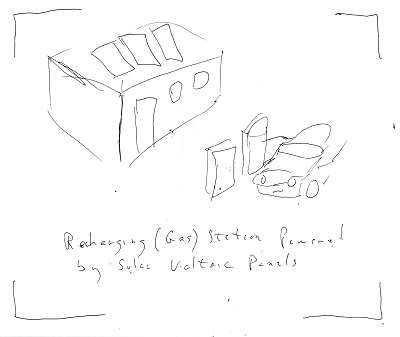 Noise Generator
Electro-magnetic interference (EMI) happens when one electrical device interferes with another. Engineers are required by law to limit a devices EMI. You can't sell a TV that interferes with a DVD player and vice versa. EMI could also be described as electro-magnetic noise. Generating noise on purpose can be useful. A separate noise device can be used to test a devices immunity to it. Ham radio noise generators can be bought on the internet. Noise can be used to jam radio's if it is at the operating frequency of the receiver and of a higher wattage. When used as a jamming device it is always aimed at the receiver. A satellite could be considered a receiver as it is 'picking up' electro-magnetic waves on the earth. There are numerous ways to generate noise. It can be difficult to generate it over the entire frequency spectrum.
The frequency spectrum is considered from DC (0hz) to about 3thz (terra hz 3,000,000,000,000). Anything above that is considered light. One of the first radios was the best way to jam the entire spectrum. The spark transmitter. A spark transmitter was used on the Titanic. It was invented by Nikola Tesla who also invented most the AC generating and distribution system we use today. A spark transmitter generates a very high wattage spark like lightning and radiates that on an antenna. A 'spark', or lightning, is plasma, the fourth state of matter. The other 3 are gas, liquid and solid. Spark transmitters were outlawed specifically because they interfered with everything. The picture below is a simplified example.
Noise Generator
Electro-magnetic interference (EMI) happens when one electrical device interferes with another. Engineers are required by law to limit a devices EMI. You can't sell a TV that interferes with a DVD player and vice versa. EMI could also be described as electro-magnetic noise. Generating noise on purpose can be useful. A separate noise device can be used to test a devices immunity to it. Ham radio noise generators can be bought on the internet. Noise can be used to jam radio's if it is at the operating frequency of the receiver and of a higher wattage. When used as a jamming device it is always aimed at the receiver. A satellite could be considered a receiver as it is 'picking up' electro-magnetic waves on the earth. There are numerous ways to generate noise. It can be difficult to generate it over the entire frequency spectrum.
The frequency spectrum is considered from DC (0hz) to about 3thz (terra hz 3,000,000,000,000). Anything above that is considered light. One of the first radios was the best way to jam the entire spectrum. The spark transmitter. A spark transmitter was used on the Titanic. It was invented by Nikola Tesla who also invented most the AC generating and distribution system we use today. A spark transmitter generates a very high wattage spark like lightning and radiates that on an antenna. A 'spark', or lightning, is plasma, the fourth state of matter. The other 3 are gas, liquid and solid. Spark transmitters were outlawed specifically because they interfered with everything. The picture below is a simplified example.
 A spark transmitter works by building up a massive store of energy in either a capacitor or inductor then discharging the energy quickly across a gap such as an automobile spark plug. The next picture is a rig I built. I mounted an ordinary lawn mower spark plug in a piece of metal and mounted it on a board. I bought an auto transformer on Amazon as the coil. It works like a regular car generator.
A spark transmitter works by building up a massive store of energy in either a capacitor or inductor then discharging the energy quickly across a gap such as an automobile spark plug. The next picture is a rig I built. I mounted an ordinary lawn mower spark plug in a piece of metal and mounted it on a board. I bought an auto transformer on Amazon as the coil. It works like a regular car generator.
 Other ways of using plasma are vacuum tubes and Nixie tubes. Vacuum tubes were used extensively before silicon transistors. Plasma is generated in a vacuum to make it less noisy and dangerous. It might be possible to use one, I don't know I didn't try. They still make them because they make cheap and reliable parts for very high power applications. Nixie tubes were the first electronic displays. They're sort of a neon technology for electronics. They can be hard to find.
I think it's possible to record the output of a spark transmitter and make a computer file out of it. Transfer the file to a small ROM chip and use it in a carry around device. Instead of analog to digital it would go digital to analog.
Other ways of using plasma are vacuum tubes and Nixie tubes. Vacuum tubes were used extensively before silicon transistors. Plasma is generated in a vacuum to make it less noisy and dangerous. It might be possible to use one, I don't know I didn't try. They still make them because they make cheap and reliable parts for very high power applications. Nixie tubes were the first electronic displays. They're sort of a neon technology for electronics. They can be hard to find.
I think it's possible to record the output of a spark transmitter and make a computer file out of it. Transfer the file to a small ROM chip and use it in a carry around device. Instead of analog to digital it would go digital to analog.
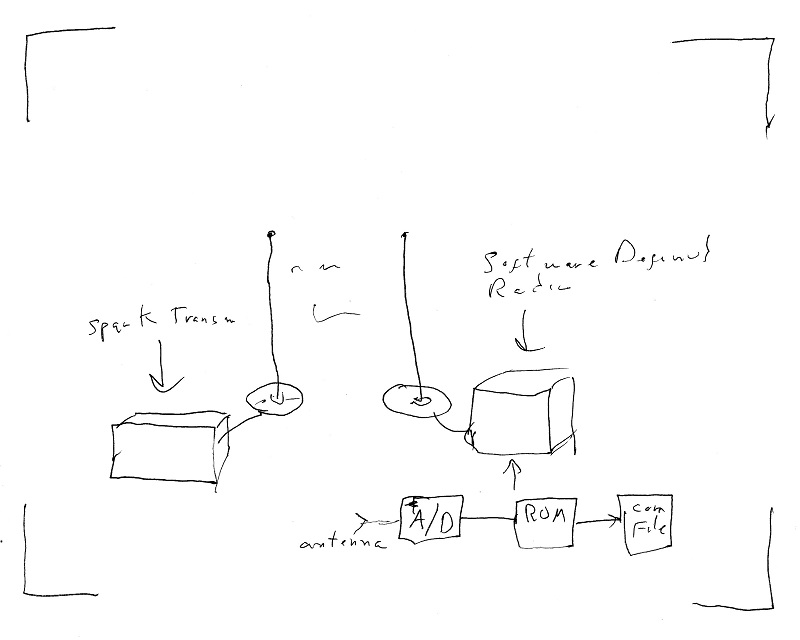 Bluetooth is a technology that allows devices to work wirelessly within a very small area. Bluetooth devices won't work beyond say 10 ft. (I'm not sure what the actual specification is) The power level any Bluetooth device produces is very small so it won't interfere with other wireless devices nearby. Personal Area Jamming devices could work at the same power level to jam your personal emissions. Any noise circuit could be attached to a necklace used for an antenna and then carried around in your pocket. Below is a picture of a piece of sterling silver Viking Weave with an electrical connector on one end. Viking Weave is one continuous piece of silver and would work well as an a antenna.
Bluetooth is a technology that allows devices to work wirelessly within a very small area. Bluetooth devices won't work beyond say 10 ft. (I'm not sure what the actual specification is) The power level any Bluetooth device produces is very small so it won't interfere with other wireless devices nearby. Personal Area Jamming devices could work at the same power level to jam your personal emissions. Any noise circuit could be attached to a necklace used for an antenna and then carried around in your pocket. Below is a picture of a piece of sterling silver Viking Weave with an electrical connector on one end. Viking Weave is one continuous piece of silver and would work well as an a antenna.
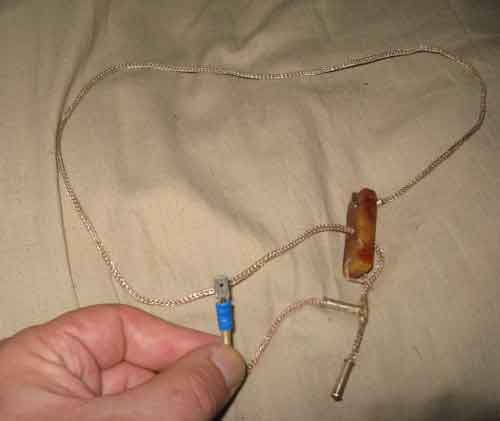 Solid state noise generators can be made in a couple ways. Avalanche, or shot, noise and circuits that produce pink, flicker, white and other types. Shot noise is produced by semiconductor PN junctions naturally. It can be drawn from the cathode of a Zener diode or a BJT transistor. (see below) Wikipedia describes shot noise in terms of probability. This is how I understand it. Current is the actual movement of electrons in a conductor. Electron movement is random whether it's AC or DC. The electrons drift from one nucleus to another randomly producing electro-magnetic waves as they go. Small currents are more random than large ones simply because there are fewer electrons. Circuits exist that produce noise without the shot phenomena. (see bottom picture)
Solid state noise generators can be made in a couple ways. Avalanche, or shot, noise and circuits that produce pink, flicker, white and other types. Shot noise is produced by semiconductor PN junctions naturally. It can be drawn from the cathode of a Zener diode or a BJT transistor. (see below) Wikipedia describes shot noise in terms of probability. This is how I understand it. Current is the actual movement of electrons in a conductor. Electron movement is random whether it's AC or DC. The electrons drift from one nucleus to another randomly producing electro-magnetic waves as they go. Small currents are more random than large ones simply because there are fewer electrons. Circuits exist that produce noise without the shot phenomena. (see bottom picture)
 Zener Diode 1N759 provides the source of shot noise
Zener Diode 1N759 provides the source of shot noise
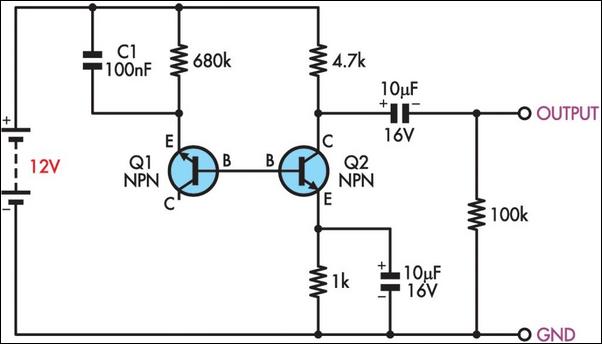 NPN Q1 provides the source of shot noise
NPN Q1 provides the source of shot noise
 Shot, white, pink and other solid state circuits have certain problems. Many don't produce intense noise over a wide range of frequencies. Shot noise needs to be amplified. Noise such as white and pink are mostly in the audio range and are very uniform. That is, not very random. I think that modern software controlled radio can remove this type very easily. It would be better if someone could come up with a circuit to break up the signal then combine them through a mixer circuit. Shot noise could also be generated multiple times then combined with a mixer to make it more intense and difficult to filter. Modern synthesizers used in music have advanced circuits that manipulate frequency and amplitude. Studying those circuits might help.
Shot, white, pink and other solid state circuits have certain problems. Many don't produce intense noise over a wide range of frequencies. Shot noise needs to be amplified. Noise such as white and pink are mostly in the audio range and are very uniform. That is, not very random. I think that modern software controlled radio can remove this type very easily. It would be better if someone could come up with a circuit to break up the signal then combine them through a mixer circuit. Shot noise could also be generated multiple times then combined with a mixer to make it more intense and difficult to filter. Modern synthesizers used in music have advanced circuits that manipulate frequency and amplitude. Studying those circuits might help.
 As a technician I know that some metals conduct electricity better than others. A signal put through a cold solder joint can be significantly altered. I think it's possible to create a component out of a metal or alloy that is a bad conductor of electricity and create noise. A way to find a metal would be to hook various wire up to a ham radio transmitter and see how noisy the result is. (see picture below) One metal I know is a bad conductor is iron. Maybe an alloy of iron and silver or copper. I think a component could be made of the metal and the output amplified and transmitted normally.
As a technician I know that some metals conduct electricity better than others. A signal put through a cold solder joint can be significantly altered. I think it's possible to create a component out of a metal or alloy that is a bad conductor of electricity and create noise. A way to find a metal would be to hook various wire up to a ham radio transmitter and see how noisy the result is. (see picture below) One metal I know is a bad conductor is iron. Maybe an alloy of iron and silver or copper. I think a component could be made of the metal and the output amplified and transmitted normally.


 This is another idea for a noise generator. Electronic music is notorious for feedback. Feedback happens when the pickup on a guitar is vibrated by the very sound coming out of it (the amplifier). The idea is to have 2 antennas very close to each other. One to transmit the other to receive. The receive circuitry would be fed back to the transmit circuitry and controlled by some random control circuit.
This is another idea for a noise generator. Electronic music is notorious for feedback. Feedback happens when the pickup on a guitar is vibrated by the very sound coming out of it (the amplifier). The idea is to have 2 antennas very close to each other. One to transmit the other to receive. The receive circuitry would be fed back to the transmit circuitry and controlled by some random control circuit.
 Recycling Electronic Parts
This is an idea for budding revolutionary’s. Modern army’s are heavily dependent on technology. Electronics is a major force in warfare and it’s cost is prohibitive to people at the bottom trying to fight back. This idea might help reduce the cost of experimenting and building technology. When I first started in electronics printed circuit boards (PCB) were assembled with parts that were called ‘through hole’. The leads of the various parts were put through a hole in the PCB and soldered on the opposite side. There was a component side and a solder side. Getting parts in and out of the PCB was difficult. Today almost everything is surface mount technology (SMT). The parts are soldered on the component side. Hobbyists have found it difficult to work and experiment with SMT but it can be done. I think getting the parts off the PCB could be fairly simple as opposed to through hole PCB's. Using a vibratory could be helpful. A vibratory uses some sort of transformer principle to vibrate. The idea is this. Build a small enclosure 20 inches by 20 inches by 10 inches tall that will withstand high heat. Place a very small vibratory unit in the bottom that can be adjusted for small vibration or large. Above the vibratory, in the middle of the enclosure, place some rubber at a steep angle. Attach to the vibratory, above the rubber and at a steep angle, a harness that will hold the PCB being stripped of components upside down. Place a heating element in the upper part of the enclosure that will heat the entire space enough to melt electric solder. As the temperature of the enclosure rises the PCB is vibrated and the parts fall in the rubber along with residual solder. The only parts of any real value are the largest IC’s. Part of the harness holding the PCB should have a cage of plastic to separate the large parts from the small and remove the residual solder. (see picture)
Recycling Electronic Parts
This is an idea for budding revolutionary’s. Modern army’s are heavily dependent on technology. Electronics is a major force in warfare and it’s cost is prohibitive to people at the bottom trying to fight back. This idea might help reduce the cost of experimenting and building technology. When I first started in electronics printed circuit boards (PCB) were assembled with parts that were called ‘through hole’. The leads of the various parts were put through a hole in the PCB and soldered on the opposite side. There was a component side and a solder side. Getting parts in and out of the PCB was difficult. Today almost everything is surface mount technology (SMT). The parts are soldered on the component side. Hobbyists have found it difficult to work and experiment with SMT but it can be done. I think getting the parts off the PCB could be fairly simple as opposed to through hole PCB's. Using a vibratory could be helpful. A vibratory uses some sort of transformer principle to vibrate. The idea is this. Build a small enclosure 20 inches by 20 inches by 10 inches tall that will withstand high heat. Place a very small vibratory unit in the bottom that can be adjusted for small vibration or large. Above the vibratory, in the middle of the enclosure, place some rubber at a steep angle. Attach to the vibratory, above the rubber and at a steep angle, a harness that will hold the PCB being stripped of components upside down. Place a heating element in the upper part of the enclosure that will heat the entire space enough to melt electric solder. As the temperature of the enclosure rises the PCB is vibrated and the parts fall in the rubber along with residual solder. The only parts of any real value are the largest IC’s. Part of the harness holding the PCB should have a cage of plastic to separate the large parts from the small and remove the residual solder. (see picture)
 Once the PCB has had all the parts removed it’s not worth anything except for the metal. I think it’s possible to separate and recover some of the metal. Build an enclosure with a grinding wheel that is airtight. Automatically feed the PCB into the grinding wheel turning it to dust. Blow the dust into another enclosure where a gas flame burns away the fiberglass in the dust. Collect the metal. Build an enclosure with a crucible attached to a vibratory and put the remaining dust in the crucible. Different metals have different melting points. Slowly raise the temperature until the first melting point is reached. Vibrate the crucible to help whatever metal is in the dust bead together. Remove the heat, open the enclosure, and remove what metal has collected and repeat the process at the next highest temperature. (see picture)
Once the PCB has had all the parts removed it’s not worth anything except for the metal. I think it’s possible to separate and recover some of the metal. Build an enclosure with a grinding wheel that is airtight. Automatically feed the PCB into the grinding wheel turning it to dust. Blow the dust into another enclosure where a gas flame burns away the fiberglass in the dust. Collect the metal. Build an enclosure with a crucible attached to a vibratory and put the remaining dust in the crucible. Different metals have different melting points. Slowly raise the temperature until the first melting point is reached. Vibrate the crucible to help whatever metal is in the dust bead together. Remove the heat, open the enclosure, and remove what metal has collected and repeat the process at the next highest temperature. (see picture)
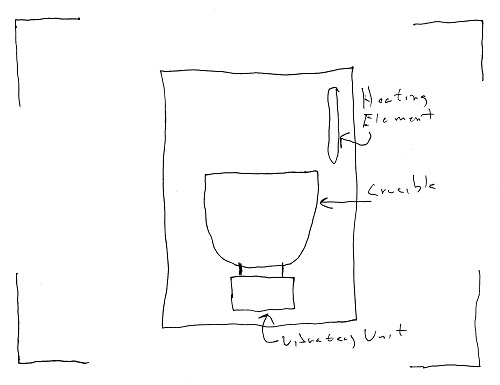 On Dec 30 and 31 2017 I posted 3 videos on youtube titled “Re-using Surface Mount Parts 1” (2 and 3). My account can be found at “www.youtube.com/zsezse215”. If no one else sees them it's proof my internet connection is censored. This is a summary of what is in them.
On my main blog “www.philipnute.wordpress.com”, I propose an invention 'Recycling Parts'. I want to try to prove that surface mount parts can be removed and reused. The top picture is what's left of a cell phone I found while out walking. Initially the 4 metal pieces were covering the main integrated circuits. I had some difficulty removing them. I eventually cut the PCB up into smaller pieces and managed to remove them without too much trouble.
On Dec 30 and 31 2017 I posted 3 videos on youtube titled “Re-using Surface Mount Parts 1” (2 and 3). My account can be found at “www.youtube.com/zsezse215”. If no one else sees them it's proof my internet connection is censored. This is a summary of what is in them.
On my main blog “www.philipnute.wordpress.com”, I propose an invention 'Recycling Parts'. I want to try to prove that surface mount parts can be removed and reused. The top picture is what's left of a cell phone I found while out walking. Initially the 4 metal pieces were covering the main integrated circuits. I had some difficulty removing them. I eventually cut the PCB up into smaller pieces and managed to remove them without too much trouble.
 The chip I want to remove this time is in the picture below. It's a Qualcomm MSM 8909 SnapDragon SOS (system on a chip).
The chip I want to remove this time is in the picture below. It's a Qualcomm MSM 8909 SnapDragon SOS (system on a chip).
 Cutting up the PCB had at least 1 advantage. It's like heating up a large frying pan or small frying pan with the same size burner. The small frying pan will heat up faster. Trying to heat up the entire PCB will take away some of the heat I am trying to concentrate on the chip. The same principle applies to the soldering hands. The alligator clips are made of metal. If the piece of PCB is too close to the alligator clip you will be heating up the clip and taking away from the area near the chip.
Cutting up the PCB had at least 1 advantage. It's like heating up a large frying pan or small frying pan with the same size burner. The small frying pan will heat up faster. Trying to heat up the entire PCB will take away some of the heat I am trying to concentrate on the chip. The same principle applies to the soldering hands. The alligator clips are made of metal. If the piece of PCB is too close to the alligator clip you will be heating up the clip and taking away from the area near the chip.
 The idea is to apply heat with an ordinary heat gun, to the underside of the PCB until the solder melts on the other side. While applying heat I will tap the soldering hands on the bench until the chip falls off. Heat guns can be bought at any home improvement store. They are used to remove paint. They are also used in electronics for shrink wrap. My gun goes up to 650 degrees F which is well above the melting point of electrical solder.
The idea is to apply heat with an ordinary heat gun, to the underside of the PCB until the solder melts on the other side. While applying heat I will tap the soldering hands on the bench until the chip falls off. Heat guns can be bought at any home improvement store. They are used to remove paint. They are also used in electronics for shrink wrap. My gun goes up to 650 degrees F which is well above the melting point of electrical solder.
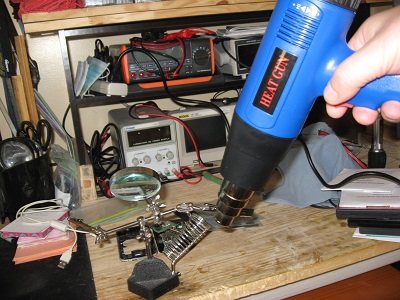 It took about 2 minutes before the chip came off. I don't know if it's usable or not. Maybe something was wrong with the phone when I found it. Too much heat can destroy small IC's. I could get a temperature probe and make sure I'm not overheating it but I just wanted to prove it could be done. Once it's off I could re-solder it to a surface mount adapter and power it up.
It took about 2 minutes before the chip came off. I don't know if it's usable or not. Maybe something was wrong with the phone when I found it. Too much heat can destroy small IC's. I could get a temperature probe and make sure I'm not overheating it but I just wanted to prove it could be done. Once it's off I could re-solder it to a surface mount adapter and power it up.
 Surface mount adapters come in all sizes. The picture below is a sample.
Surface mount adapters come in all sizes. The picture below is a sample.
 Printed Circuit Board Manufacturing
The old way of making blank printed circuit boards requires a lot of chemicals and machinery. Chemicals include acids, electroplating solutions and photo resist. The processes include photography, ultraviolet light, etching with acids, drilling holes, and electroplating. It’s dirty, time consuming and inexact. Components must be added later with different machines. Many of the chemicals are oil based. It is very labor intensive. Companies sometimes employ hundreds of people to inspect the boards for shorts and opens. The picture below is a blank copper board.
Printed Circuit Board Manufacturing
The old way of making blank printed circuit boards requires a lot of chemicals and machinery. Chemicals include acids, electroplating solutions and photo resist. The processes include photography, ultraviolet light, etching with acids, drilling holes, and electroplating. It’s dirty, time consuming and inexact. Components must be added later with different machines. Many of the chemicals are oil based. It is very labor intensive. Companies sometimes employ hundreds of people to inspect the boards for shorts and opens. The picture below is a blank copper board.
 The top three pictures are examples. The top picture is an artwork. The artwork must be converted to a photo negative. A blank board is covered with photo-resist. The negative is placed on top and exposed to ultra-violet light. The photo resist that is exposed to ultra violet hardens and will not come off during the first washing with acid thus leaving the copper connections. The board is then washed with another type of acid removing all the photo resist. The second picture is a board without the components and the third with.
The top three pictures are examples. The top picture is an artwork. The artwork must be converted to a photo negative. A blank board is covered with photo-resist. The negative is placed on top and exposed to ultra-violet light. The photo resist that is exposed to ultra violet hardens and will not come off during the first washing with acid thus leaving the copper connections. The board is then washed with another type of acid removing all the photo resist. The second picture is a board without the components and the third with.
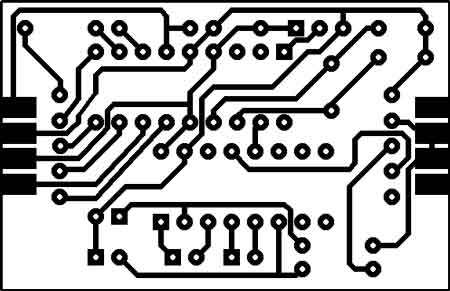

 In one idea a cutting bit cuts the connections. Connections are passed from bottom to top by inserting and soldering wire. The other idea is to spread a conductive substance around, something like the car defogger, with a computer. The advantages are many. Faster manufacturing time, less cost, fewer chemicals and more exact. R and D can be sped up.
In one idea a cutting bit cuts the connections. Connections are passed from bottom to top by inserting and soldering wire. The other idea is to spread a conductive substance around, something like the car defogger, with a computer. The advantages are many. Faster manufacturing time, less cost, fewer chemicals and more exact. R and D can be sped up.

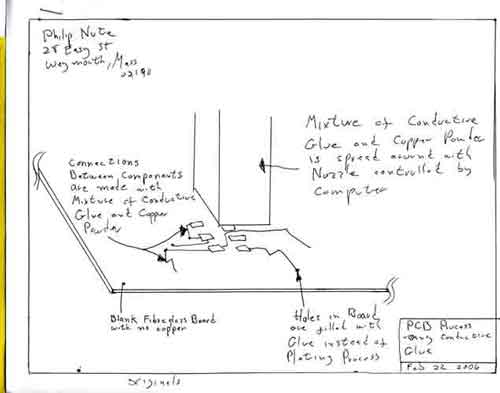

 For most people PCB layout and etching services are beyond their pocketbook and when developing new products etching services are even more expensive because of the low number of PCB’s ordered. This is a way to avoid all services and `at the same time and speed up your R&D. The pictures below are 1. a Dremel stand 2. Copper coated blank G10. and 3. a x-y table for drill press. A Dremel is a common household tool sold almost anywhere tools are sold. It can be fitted with drills carving bits sand paper etc. The top picture is a Dremel stand (sold separately from the Dremel) that can be an accurate drill press for drilling holes in your PCB (G10 blank copper). The middle picture is of G10 blank copper. The third picture is a low profile x-y table that could be positioned under the Dremel stand, it could hold the G10 and be used to ‘carve’ away the copper instead of etching. You would have to do your own layout but building the actual prototype would be much faster and cheaper.
For most people PCB layout and etching services are beyond their pocketbook and when developing new products etching services are even more expensive because of the low number of PCB’s ordered. This is a way to avoid all services and `at the same time and speed up your R&D. The pictures below are 1. a Dremel stand 2. Copper coated blank G10. and 3. a x-y table for drill press. A Dremel is a common household tool sold almost anywhere tools are sold. It can be fitted with drills carving bits sand paper etc. The top picture is a Dremel stand (sold separately from the Dremel) that can be an accurate drill press for drilling holes in your PCB (G10 blank copper). The middle picture is of G10 blank copper. The third picture is a low profile x-y table that could be positioned under the Dremel stand, it could hold the G10 and be used to ‘carve’ away the copper instead of etching. You would have to do your own layout but building the actual prototype would be much faster and cheaper.


 Software Defined Universal Electronic Input Output Device
Having an oscilloscope, spectrum analyzer and a function generator that operates from DC to well into microwaves could be very useful. It is probably very expensive to purchase these if they would sell them to you which they wouldn't if they knew what you were going to do with them. I think it would also be useful to have a radio that can receive and transmit anything from DC to microwaves in every type of modulation. It could be used as an alternative relay communication system. It would be helpful to generate all kinds of noise from DC to microwaves at the same time. I think this could all be accomplished with one device I call a Software Defined Universal Electronic Input Output Device.
Software Defined Radio is the latest thing in ham radio so much of the technology already exists. The pictures below is something I've been working on. I bought these parts from tapr.org (Tucson ) I found that website through hpsdr.com. (high performance software defined radio) It consists of a backplane mounted in an aluminum enclosure with a fan and a separate enclosure for an RF front end. The backplane has a standard ATX12v connector for power. It will supply +12v, -12v, +5v, -5v and 3.3v to every board plugged in. You can build whatever you want in each slot.
Software Defined Radio (SDR) uses the latest technology in digital signal processing (DSP). DSP can go two ways, analog to digital and digital to analog. Analog to digital converts any signal to a stream of digital data that can be operated on by a computer. Digital to analog has the computer create the data stream and convert it to an analog signal. This can all be accomplished with a personal computer and a universal electronic device.
Software Defined Universal Electronic Input Output Device
Having an oscilloscope, spectrum analyzer and a function generator that operates from DC to well into microwaves could be very useful. It is probably very expensive to purchase these if they would sell them to you which they wouldn't if they knew what you were going to do with them. I think it would also be useful to have a radio that can receive and transmit anything from DC to microwaves in every type of modulation. It could be used as an alternative relay communication system. It would be helpful to generate all kinds of noise from DC to microwaves at the same time. I think this could all be accomplished with one device I call a Software Defined Universal Electronic Input Output Device.
Software Defined Radio is the latest thing in ham radio so much of the technology already exists. The pictures below is something I've been working on. I bought these parts from tapr.org (Tucson ) I found that website through hpsdr.com. (high performance software defined radio) It consists of a backplane mounted in an aluminum enclosure with a fan and a separate enclosure for an RF front end. The backplane has a standard ATX12v connector for power. It will supply +12v, -12v, +5v, -5v and 3.3v to every board plugged in. You can build whatever you want in each slot.
Software Defined Radio (SDR) uses the latest technology in digital signal processing (DSP). DSP can go two ways, analog to digital and digital to analog. Analog to digital converts any signal to a stream of digital data that can be operated on by a computer. Digital to analog has the computer create the data stream and convert it to an analog signal. This can all be accomplished with a personal computer and a universal electronic device.
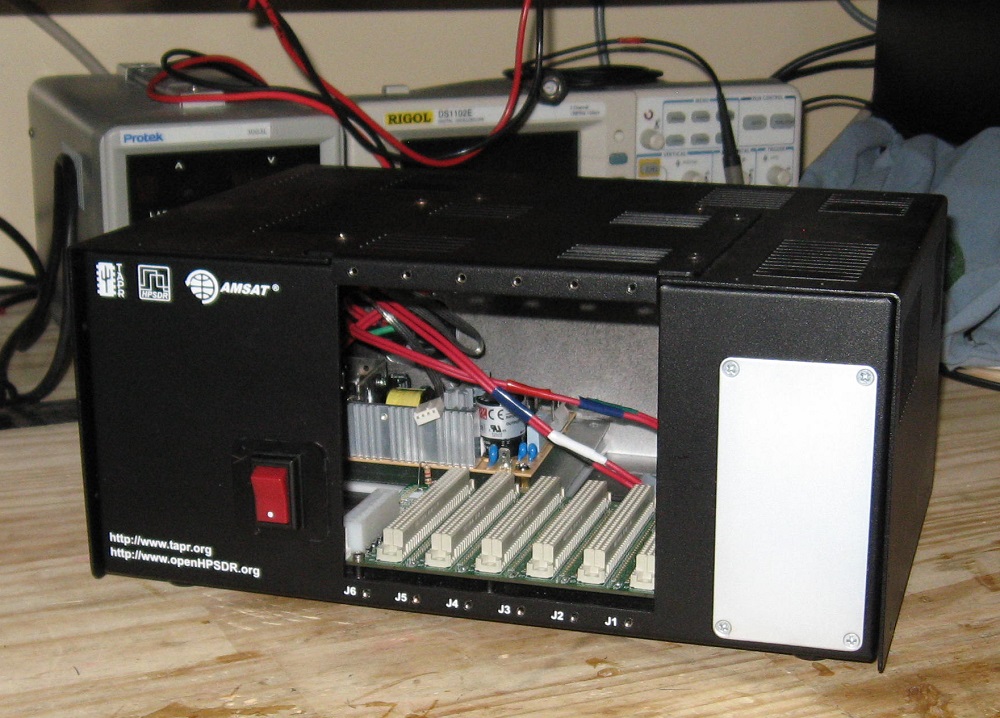
 Since starting this project I have discovered backplane's are made as a standard part as well as the power supplies that come with them. One supplier is Vector Electronics based in Los Angeles. There are companies that make development kits that come with everything you need. The various engineering societies have produced standards for buses used on backplanes. IEEE, IEC and ANSI. One such standard is a VME bus IEEE 1014. I found a kit at elma.com. Model VITA Type 15 4U Rackmount Desktop.
Updated Sept 6 2017
This is a rough idea of what the RF front end (input circuit) would look like. The original signal would come in on either an antenna or an oscilloscope probe. The original signal would never go through any parts, passive or active. The various factors needed for the computer software (ie frequency, voltage, current etc) would be taken off the original signal bus then turned into digital data. All the digital data would go into a parallel to serial converter and transferred to the PC on the USB serial bus. I figure it doesn't matter what data you transfer, if you don't need it for a particular software application then don't use it.
Since starting this project I have discovered backplane's are made as a standard part as well as the power supplies that come with them. One supplier is Vector Electronics based in Los Angeles. There are companies that make development kits that come with everything you need. The various engineering societies have produced standards for buses used on backplanes. IEEE, IEC and ANSI. One such standard is a VME bus IEEE 1014. I found a kit at elma.com. Model VITA Type 15 4U Rackmount Desktop.
Updated Sept 6 2017
This is a rough idea of what the RF front end (input circuit) would look like. The original signal would come in on either an antenna or an oscilloscope probe. The original signal would never go through any parts, passive or active. The various factors needed for the computer software (ie frequency, voltage, current etc) would be taken off the original signal bus then turned into digital data. All the digital data would go into a parallel to serial converter and transferred to the PC on the USB serial bus. I figure it doesn't matter what data you transfer, if you don't need it for a particular software application then don't use it.
 Soldering Iron Attachment
This is an idea for hobbyists who fool around with electronics or hackers who fool around with the government. You know what a pain it is to work with surface mount components. It’s difficult to get them on and off boards. Any ordinary soldering iron will have replaceable tips. Tips come in different sizes and shapes. The shaft that holds the tip can get as hot as the tip itself so the idea is to fashion a piece of metal to slip over the shaft. You can make the end of the metal any shape you want. The top picture is one I made that I never did anything with. I could cut a square hole in it the exact shape of an IC and heat up every pin at the same time. (second picture) By holding the board upside-down I could get the chip off without too much effort. Sometimes it’s good to heat up both ends of a resistor at the same time. (see bottom picture) Small pieces of sheet metal can be bought from any hardware store. I think ?? (I’m not sure) stainless will not accept solder. The lighter the gauge the better, because it will be easier to heat up.
Soldering Iron Attachment
This is an idea for hobbyists who fool around with electronics or hackers who fool around with the government. You know what a pain it is to work with surface mount components. It’s difficult to get them on and off boards. Any ordinary soldering iron will have replaceable tips. Tips come in different sizes and shapes. The shaft that holds the tip can get as hot as the tip itself so the idea is to fashion a piece of metal to slip over the shaft. You can make the end of the metal any shape you want. The top picture is one I made that I never did anything with. I could cut a square hole in it the exact shape of an IC and heat up every pin at the same time. (second picture) By holding the board upside-down I could get the chip off without too much effort. Sometimes it’s good to heat up both ends of a resistor at the same time. (see bottom picture) Small pieces of sheet metal can be bought from any hardware store. I think ?? (I’m not sure) stainless will not accept solder. The lighter the gauge the better, because it will be easier to heat up.
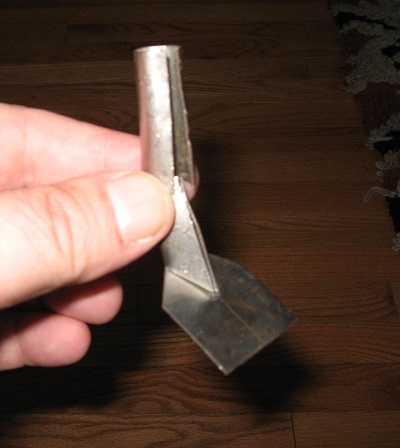
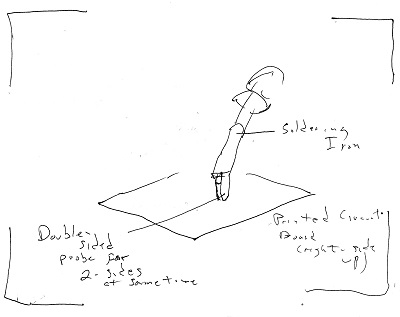
 Spark Transmitter
Spark generators were one of the first Morse Code machines. They were invented by Nikola Tesla before the end of the 19th century. The Titanic carried a spark transmitter (generator). As radio progressed they were outlawed because they interfered with the entire radio spectrum. A Jacobs Ladder is a type of spark generator. At high voltages they can interrupt everything. A basic spark transmitter can be built from off the shelf parts. I mounted a standard spark plug from an internal combustion engine in a piece of metal and mounted that on a board. To create the spark I used a standard ignition coil with a Velleman kit. The Velleman kit (K2543) comes with everything needed, but it has to be assembled. The coil is an auto-transformer that can be bought on Amazon. Auto-transformers are used in cars to generate the spark.
Spark Transmitter
Spark generators were one of the first Morse Code machines. They were invented by Nikola Tesla before the end of the 19th century. The Titanic carried a spark transmitter (generator). As radio progressed they were outlawed because they interfered with the entire radio spectrum. A Jacobs Ladder is a type of spark generator. At high voltages they can interrupt everything. A basic spark transmitter can be built from off the shelf parts. I mounted a standard spark plug from an internal combustion engine in a piece of metal and mounted that on a board. To create the spark I used a standard ignition coil with a Velleman kit. The Velleman kit (K2543) comes with everything needed, but it has to be assembled. The coil is an auto-transformer that can be bought on Amazon. Auto-transformers are used in cars to generate the spark.
 Auto-transformers work by storing a large charge of energy in a coil, then when the energy source is removed, the stored energy is given a path to flow through a gap, such as a spark plug. When this happens it makes a spark. A schematic is below. This particular version isolates the antenna from the circuit with a transformer. The antenna is grounded to earth to complete the circuit on the secondary.
Auto-transformers work by storing a large charge of energy in a coil, then when the energy source is removed, the stored energy is given a path to flow through a gap, such as a spark plug. When this happens it makes a spark. A schematic is below. This particular version isolates the antenna from the circuit with a transformer. The antenna is grounded to earth to complete the circuit on the secondary.
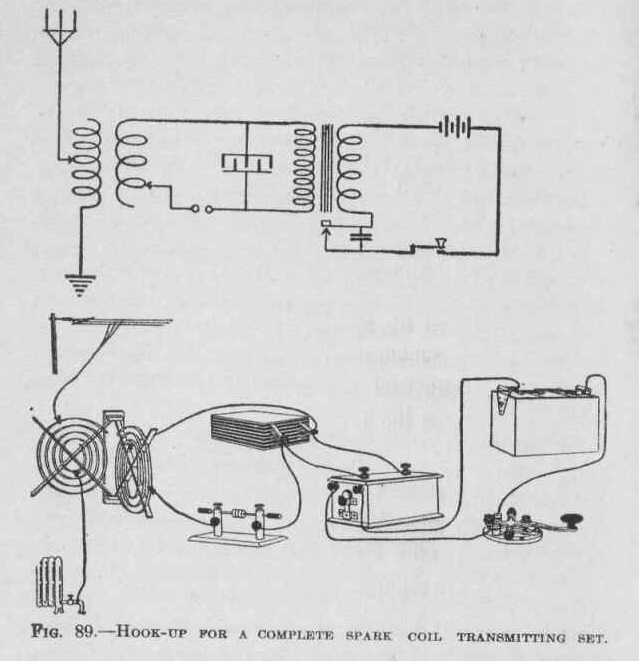 A spark is considered the fourth state of matter. The others are: gas, fluid and solid. (ex. Steam, water and ice) A more scientific name is plasma. Other sources of plasma are vacuum tubes and Nixie tubes. Capacitors can be used in place of auto-transformers. (see picture)
This schematic is over simplified. It has no way to vary the source to create AC. If there was a switch between the source and R when it is thrown C1 would charge through R. The source is then removed, and C1 would discharge through C2 and L by 'jumping' the gap. The antenna between C2 and L would radiate a very interfering signal.
A spark is considered the fourth state of matter. The others are: gas, fluid and solid. (ex. Steam, water and ice) A more scientific name is plasma. Other sources of plasma are vacuum tubes and Nixie tubes. Capacitors can be used in place of auto-transformers. (see picture)
This schematic is over simplified. It has no way to vary the source to create AC. If there was a switch between the source and R when it is thrown C1 would charge through R. The source is then removed, and C1 would discharge through C2 and L by 'jumping' the gap. The antenna between C2 and L would radiate a very interfering signal.
 I think it would be possible to 'record' the interference created by a spark generator, make a computer file out of it, then use it in a small hand held personal area network jamming device.
I think it would be possible to 'record' the interference created by a spark generator, make a computer file out of it, then use it in a small hand held personal area network jamming device.
 Electric Heat
Solar panels convert sunlight to DC electric current with semiconductor technology. They use the same PN junction used in every transistor. Silicon transistors can make light. It’s called an LED. (Light Emitting Diode) So it can both make electricity from light and make light from electricity. That's about as much as I know.
There are 3 types of solar panels. Amorphous, poly-crystalline and mono-crystalline. Amorphous are the least sensitive and cheapest. Poly-crystalline are in the middle and mono-crystalline are the most sensitive and costly. Amorphous are best used near the equator where there is abundant direct sunlight. They don’t work very well near the poles. (north and south) It is best to use the most sensitive where the sunlight is not as direct.
Any integrated circuit (IC) has millions of transistors with millions of PN junctions. Soon after IC's were invented someone predicted that the number of transistors per square inch would double every 18 months. That was sometime in the 1950's. By the 1970's Intel had made the first microprocessor with millions of transistors. Engineers referred to the progression as Small Scale Integration (SSI) then they went to Large Scale Integration (LSI) Then VLSI and so on. In a world dominated by oil companies I wonder if photo voltaic panels were ever produced with the new technology. It would put the oil companies out of business. I also know that there are different processes for the different types of light. Infrared, ultra violet and visible. Maybe combining today's integration technology and all the various light types if the amount of current produced by photo voltaic panels can be significantly increased.
The manufacturing process for creating IC's is very similar to the process that makes PCB's. (printed circuit boards) It is very chemical dependent and requires a number of steps. I wonder if the technology that makes CD's can be used to create IC's. Every computer sold today comes with a CD burner. It uses a LASER to burn 'holes' in the bottom of a blank CD. The 'hole' is microscopic. I think it's possible to make IC's with LASER's this would eliminate chemicals and make them cheaper.
The picture below shows 6 panels. This might be 1000 watts on a very sunny day. To help you understand, a desktop personal computer would be a constant 600 watts. A laptop or notebook less. A microwave oven is typically 1200 watts. You can’t use them at night unless you store the energy somehow. There are at least two ways to produce the electricity at a later time. One is batteries and the other is with a fuel cell. (see second picture below) A fuel cell combines hydrogen and oxygen to make electricity and you get water as a by-product. Since solar panels make DC current it can be used to separate hydrogen and oxygen with a process known as electrolysis. The 2 components can be generated during the day and stored in 2 separate containers and then recombined at night. The third picture below is a small desktop separator.
Hydrogen is the smallest atom in the universe. It can be hard to store because it can pass through many other substances. I think you could make an ordinary steel container like those used to store other gases and line it with glass. Glass is very dense. This would make the walls very thick. It might be possible to find a glass that would combine with hydrogen and over time increase it's ability to hold the gas.
Electric Heat
Solar panels convert sunlight to DC electric current with semiconductor technology. They use the same PN junction used in every transistor. Silicon transistors can make light. It’s called an LED. (Light Emitting Diode) So it can both make electricity from light and make light from electricity. That's about as much as I know.
There are 3 types of solar panels. Amorphous, poly-crystalline and mono-crystalline. Amorphous are the least sensitive and cheapest. Poly-crystalline are in the middle and mono-crystalline are the most sensitive and costly. Amorphous are best used near the equator where there is abundant direct sunlight. They don’t work very well near the poles. (north and south) It is best to use the most sensitive where the sunlight is not as direct.
Any integrated circuit (IC) has millions of transistors with millions of PN junctions. Soon after IC's were invented someone predicted that the number of transistors per square inch would double every 18 months. That was sometime in the 1950's. By the 1970's Intel had made the first microprocessor with millions of transistors. Engineers referred to the progression as Small Scale Integration (SSI) then they went to Large Scale Integration (LSI) Then VLSI and so on. In a world dominated by oil companies I wonder if photo voltaic panels were ever produced with the new technology. It would put the oil companies out of business. I also know that there are different processes for the different types of light. Infrared, ultra violet and visible. Maybe combining today's integration technology and all the various light types if the amount of current produced by photo voltaic panels can be significantly increased.
The manufacturing process for creating IC's is very similar to the process that makes PCB's. (printed circuit boards) It is very chemical dependent and requires a number of steps. I wonder if the technology that makes CD's can be used to create IC's. Every computer sold today comes with a CD burner. It uses a LASER to burn 'holes' in the bottom of a blank CD. The 'hole' is microscopic. I think it's possible to make IC's with LASER's this would eliminate chemicals and make them cheaper.
The picture below shows 6 panels. This might be 1000 watts on a very sunny day. To help you understand, a desktop personal computer would be a constant 600 watts. A laptop or notebook less. A microwave oven is typically 1200 watts. You can’t use them at night unless you store the energy somehow. There are at least two ways to produce the electricity at a later time. One is batteries and the other is with a fuel cell. (see second picture below) A fuel cell combines hydrogen and oxygen to make electricity and you get water as a by-product. Since solar panels make DC current it can be used to separate hydrogen and oxygen with a process known as electrolysis. The 2 components can be generated during the day and stored in 2 separate containers and then recombined at night. The third picture below is a small desktop separator.
Hydrogen is the smallest atom in the universe. It can be hard to store because it can pass through many other substances. I think you could make an ordinary steel container like those used to store other gases and line it with glass. Glass is very dense. This would make the walls very thick. It might be possible to find a glass that would combine with hydrogen and over time increase it's ability to hold the gas.


 Another problem with solar panels is snow. Snow would cover the panel and prevent light from getting through. There are ways to solve this. A car rear window de-fogger uses small amounts of electricity to melt ice on your car. It’s something like an electric stove. It has small lines of a resistive substance that heat up when current is passed through. If solar panels are kept very thin they could be put on the bottom so as not to stop sunlight. Panels could be made as small as possible. Instead of 6 panels 3 feet by 6 feet you could make 18 panels 1 foot by 1 foot. Raise the panels up off the roof and separate them by a couple inches to allow water to fall off. Making them smaller can also help if one goes bad. Replacing a 6 by 3 would be more expensive than a 1 by 1.
Solar voltaic panels can be used to heat a home as well. The top picture below is an electric stove top. It glows red when electricity flows through it. The bottom picture is a possible application. The idea is to wrap the element around a piece of pipe and send water through the pipe so it picks up the heat. Two things could be done. One is to preheat an existing fossil fuel heating system (oil, natural gas etc) by placing the pipe in-line with the zones of the house. The furnace would not stay on as long or maybe not come on at all. This would cut down on the amount of fossil fuel used and it could also be an incentive for people to purchase photo voltaic panels while the technology is improved. Another use would be putting a unit right where hot water is needed like the kitchen or bathroom. This would cut down on the amount of piping needed and eliminate the need for a hot water tank.
Another problem with solar panels is snow. Snow would cover the panel and prevent light from getting through. There are ways to solve this. A car rear window de-fogger uses small amounts of electricity to melt ice on your car. It’s something like an electric stove. It has small lines of a resistive substance that heat up when current is passed through. If solar panels are kept very thin they could be put on the bottom so as not to stop sunlight. Panels could be made as small as possible. Instead of 6 panels 3 feet by 6 feet you could make 18 panels 1 foot by 1 foot. Raise the panels up off the roof and separate them by a couple inches to allow water to fall off. Making them smaller can also help if one goes bad. Replacing a 6 by 3 would be more expensive than a 1 by 1.
Solar voltaic panels can be used to heat a home as well. The top picture below is an electric stove top. It glows red when electricity flows through it. The bottom picture is a possible application. The idea is to wrap the element around a piece of pipe and send water through the pipe so it picks up the heat. Two things could be done. One is to preheat an existing fossil fuel heating system (oil, natural gas etc) by placing the pipe in-line with the zones of the house. The furnace would not stay on as long or maybe not come on at all. This would cut down on the amount of fossil fuel used and it could also be an incentive for people to purchase photo voltaic panels while the technology is improved. Another use would be putting a unit right where hot water is needed like the kitchen or bathroom. This would cut down on the amount of piping needed and eliminate the need for a hot water tank.


 The picture above is a suggestion for how future houses can be built to use photo voltaic panels. The house would be built with a chase from the roof to the basement. The chase would have duct for a forced hot water system where multiple sources of heat can be used with multiple heat exchangers for different types of sources. Part of the chase would hold the wires from the panels on the roof. Each floor would have shelves that hold batteries that charge while on the shelf. If someone wanted to run something (laptop, coffee pot etc) they would take a battery off the shelf, use it, then put it back. It really wouldn't be much different from the days when you had to fill a lamp with kerosene. During the day when people are at work the batteries charge. At night they are used. The house can be kept warm during the day with the panels. There would be no need to put wires in the walls except for things like refrigerator, TV, or stove.
The picture above is a suggestion for how future houses can be built to use photo voltaic panels. The house would be built with a chase from the roof to the basement. The chase would have duct for a forced hot water system where multiple sources of heat can be used with multiple heat exchangers for different types of sources. Part of the chase would hold the wires from the panels on the roof. Each floor would have shelves that hold batteries that charge while on the shelf. If someone wanted to run something (laptop, coffee pot etc) they would take a battery off the shelf, use it, then put it back. It really wouldn't be much different from the days when you had to fill a lamp with kerosene. During the day when people are at work the batteries charge. At night they are used. The house can be kept warm during the day with the panels. There would be no need to put wires in the walls except for things like refrigerator, TV, or stove.
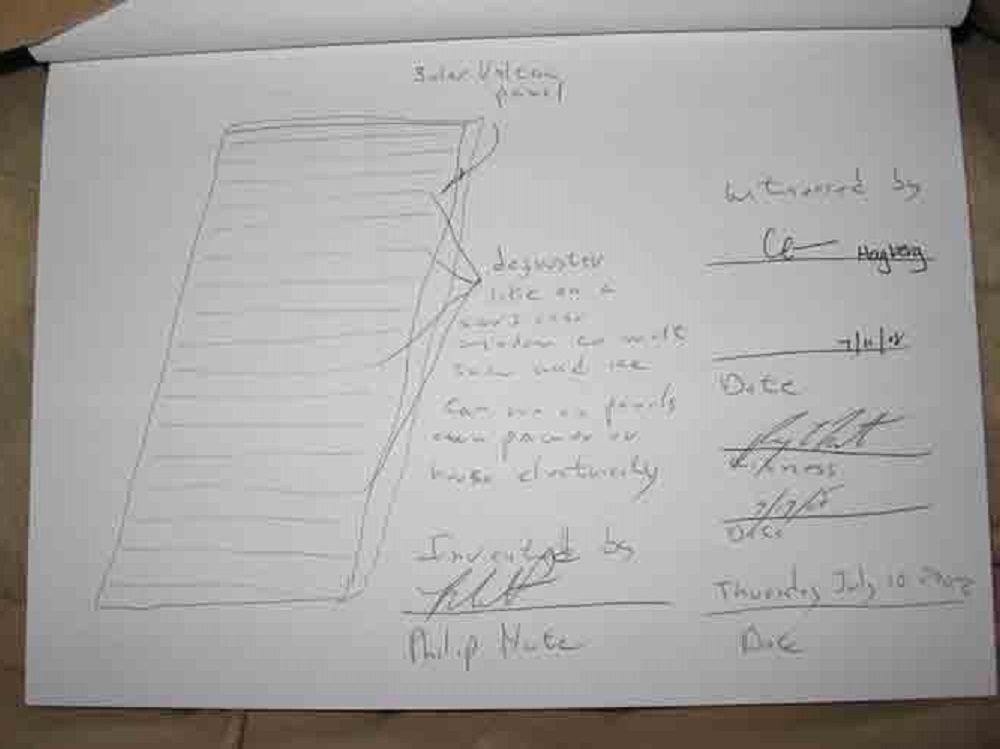 Funnel Wind Turbine
This is an alternative to wind powered electric generators. Instead of having large propellers the wind is collected by a funnel that compresses the air to increase the velocity. This can turn a 5 MPH wind into a more powerful force capable turning a larger generator. The funnel could sit atop a building and not be as conspicuous as a propeller. It would sit on a rotating platform that could turn at least 180 degrees. The turbine is basically a fan that is turned by the wind instead of creating it. The horizontal rotation is converted to vertical and passed into the building where the generator is located. Some sort of mechanical governor would be needed to limit the RPM of the shaft.
Funnel Wind Turbine
This is an alternative to wind powered electric generators. Instead of having large propellers the wind is collected by a funnel that compresses the air to increase the velocity. This can turn a 5 MPH wind into a more powerful force capable turning a larger generator. The funnel could sit atop a building and not be as conspicuous as a propeller. It would sit on a rotating platform that could turn at least 180 degrees. The turbine is basically a fan that is turned by the wind instead of creating it. The horizontal rotation is converted to vertical and passed into the building where the generator is located. Some sort of mechanical governor would be needed to limit the RPM of the shaft.

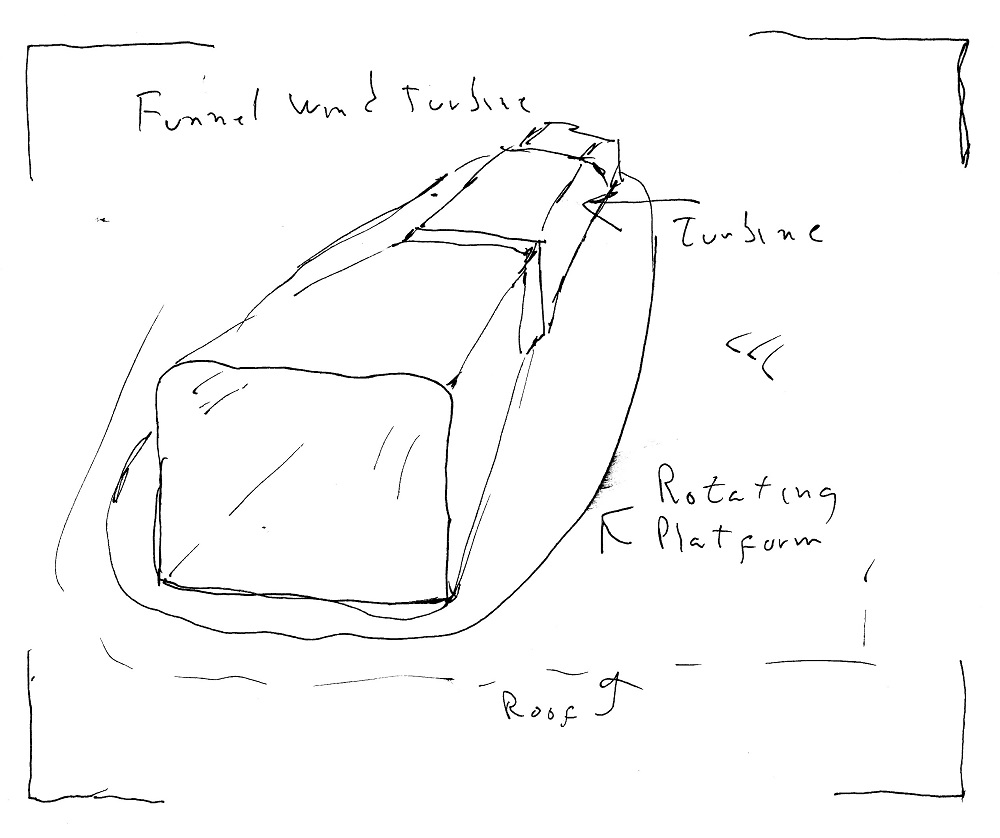
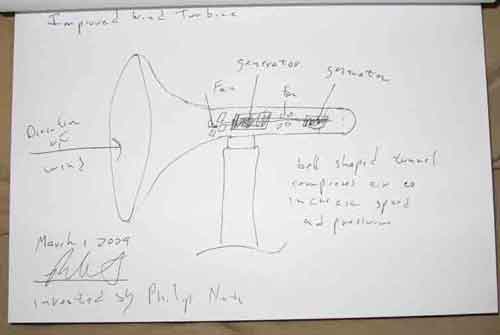
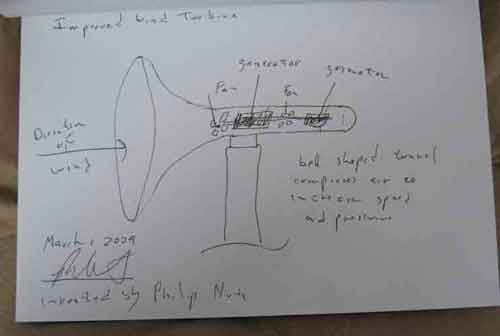 Alternative Home Heat
Central heating is heavily dependent on fossil fuels. The most popular types are heating oil, natural gas and propane. Less popular are methane, coal and firewood. Most buildings, especially small ones, have only one type of heating. It's too expensive to buy more than one furnace. Many large buildings have a back-up. Electricity can be used but is very expensive. If solar panels are used they can heat the house during the day when someone is at work. One way of using electricity was to put a heating element in every room just like forced hot water. I think it's possible to combine the 2 and others and have a computer figure out which is the best at any given time. Whether the home has the water in pipes or coming out a duct system the heat can be added to the water in many ways with a bank of heat exchangers. (see picture)
Alternative Home Heat
Central heating is heavily dependent on fossil fuels. The most popular types are heating oil, natural gas and propane. Less popular are methane, coal and firewood. Most buildings, especially small ones, have only one type of heating. It's too expensive to buy more than one furnace. Many large buildings have a back-up. Electricity can be used but is very expensive. If solar panels are used they can heat the house during the day when someone is at work. One way of using electricity was to put a heating element in every room just like forced hot water. I think it's possible to combine the 2 and others and have a computer figure out which is the best at any given time. Whether the home has the water in pipes or coming out a duct system the heat can be added to the water in many ways with a bank of heat exchangers. (see picture)
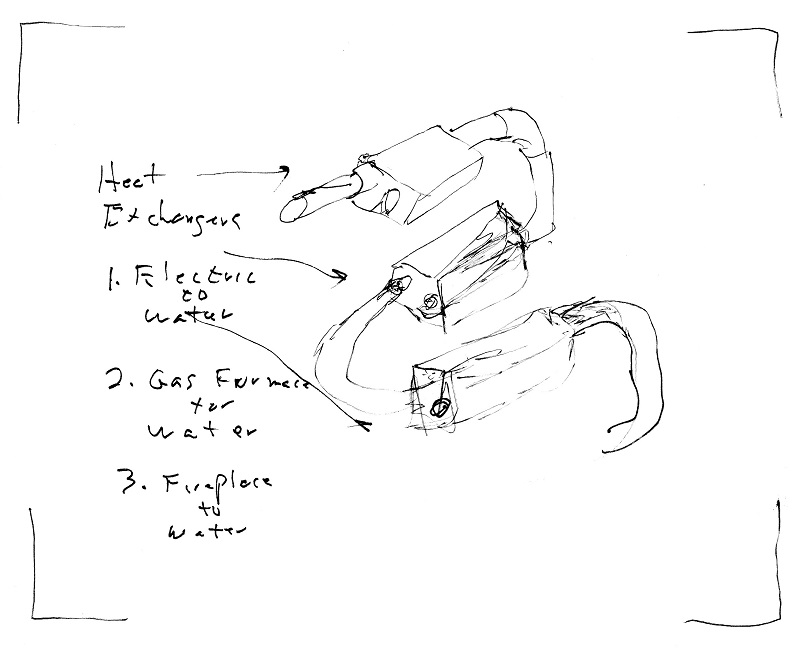



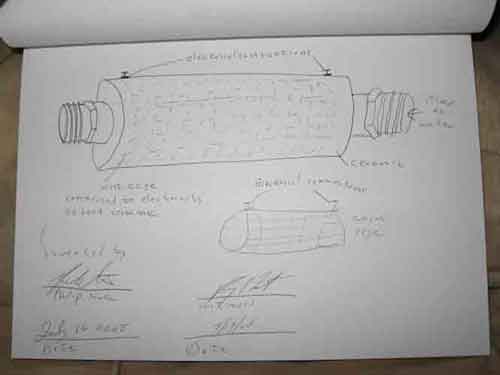
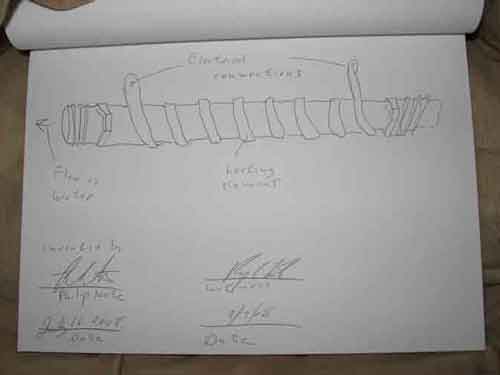

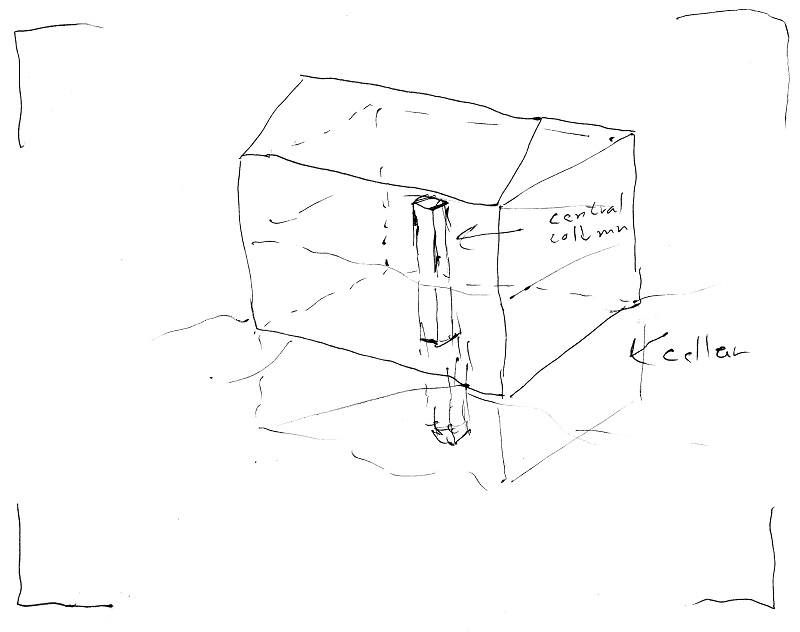
 Methane Silo
Methane is a naturally occurring gas produced by the decay of organic material such as animal waste or plants. It is a fossil fuel like oil propane or butane. It can be used to produce mechanical or electrical power. It’s chemical formula is CH4. One atom of carbon and 4 atoms of hydrogen. Like any gas it is best transported by pipeline or used where it is produced. Some attempts to harness methane involve laying out plant material in large sealed buildings and collecting it as the material decays. (see picture below) One problem with this is the material must be turned over every so often to help the material decay. As the material decays it gives off less and less methane. A methane silo eliminates the need to do this. A methane silo works as any silo by gravity. The material is fed into the top and comes out the bottom. The difference is a methane silo would have long tubes of screen inside the silo to help expose the material to the air to help it decay and give off methane. This eliminates the need to turn it.
Methane Silo
Methane is a naturally occurring gas produced by the decay of organic material such as animal waste or plants. It is a fossil fuel like oil propane or butane. It can be used to produce mechanical or electrical power. It’s chemical formula is CH4. One atom of carbon and 4 atoms of hydrogen. Like any gas it is best transported by pipeline or used where it is produced. Some attempts to harness methane involve laying out plant material in large sealed buildings and collecting it as the material decays. (see picture below) One problem with this is the material must be turned over every so often to help the material decay. As the material decays it gives off less and less methane. A methane silo eliminates the need to do this. A methane silo works as any silo by gravity. The material is fed into the top and comes out the bottom. The difference is a methane silo would have long tubes of screen inside the silo to help expose the material to the air to help it decay and give off methane. This eliminates the need to turn it.
 The silo would be square. The columns of material would extend the length of one side. The ends of the columns would face 2 sides opposite each other. The top would be shaped like a roof so the material would distribute evenly down each column. The entire space containing the material would be airtight. A plenum would be placed at the 2 ends facing all columns. One plenum at the bottom and the other at the top. The bottom plenum would allow air in when methane is being withdrawn from the top. There would be a series of valves controlled by electronics. Once material has completely filled the airtight space, a vacuum pump creates a vacuum. As methane is produced pressure builds up. When it gets high enough valves on both plenums open and remove methane. When pressure drops, the valves close and the vacuum pump creates another vacuum. This process concentrates the methane and reduces the amount of unwanted gas (air) in the final product.
The silo would be square. The columns of material would extend the length of one side. The ends of the columns would face 2 sides opposite each other. The top would be shaped like a roof so the material would distribute evenly down each column. The entire space containing the material would be airtight. A plenum would be placed at the 2 ends facing all columns. One plenum at the bottom and the other at the top. The bottom plenum would allow air in when methane is being withdrawn from the top. There would be a series of valves controlled by electronics. Once material has completely filled the airtight space, a vacuum pump creates a vacuum. As methane is produced pressure builds up. When it gets high enough valves on both plenums open and remove methane. When pressure drops, the valves close and the vacuum pump creates another vacuum. This process concentrates the methane and reduces the amount of unwanted gas (air) in the final product.


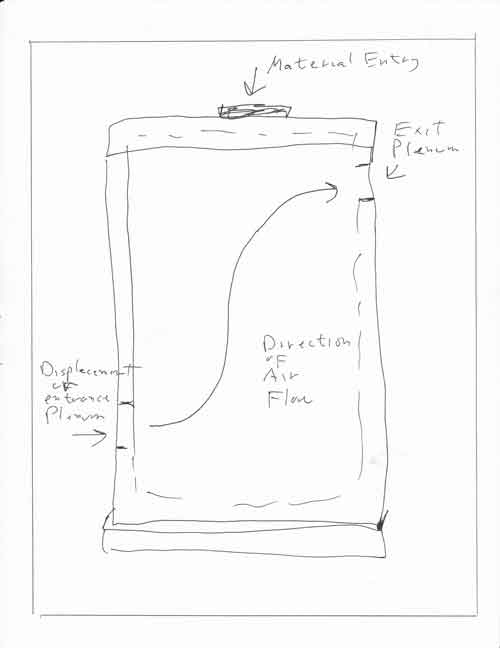

 Every check that goes out the door at the end of the month is another link in the ball and chain of our system. Reducing energy costs for small businesses and small business owners would do more to help the economy than one tax cut for Exxon Mobil. It would help to break up these big companies. Waiting for the government to break them up is hopeless. Putting them out of business with alternative technology is more practical. It used to be that people understood that being your own boss was much better than working for a big company. There is no crime in owning a small business. As fossil fuels run out the ability of big corporations to move things around will go with them. A localized economy is coming to a neighborhood near you. People will be forced to go back to traditional occupations such as farmer, butcher etc.
The chemical makeup of methane is CH4. One atom of carbon and 4 atoms of hydrogen. Coal is mostly carbon. If someone could come up with a process to separate the carbon from the hydrogen it could be mixed with some type of bio material to create synthetic coal. We are running out of natural deposits of coal and most of the worlds electricity is generated by coal.
Radiant Lights
Any light bulb produces a lot of heat. Fluorescent lights are no different. Fluorescent lights are used extensively in large buildings and strip malls. They are used along with suspended ceilings. Many fit into the same space as 1 tile. Suspended ceilings are heat sieves. They provide absolutely no insulation and waste more money for small businesses than anything else. Small businesses in strip malls should build their ceilings out of the same material as the walls and insulate them very heavily. I mean 2 X 6 's and sheet rock with fiberglass insulation. Along with this they could use radiant lights to heat the space. Radiant lights would be built in such a way as to transfer the heat generated by the bulbs to the side then have a fan blow it into the room.
Every check that goes out the door at the end of the month is another link in the ball and chain of our system. Reducing energy costs for small businesses and small business owners would do more to help the economy than one tax cut for Exxon Mobil. It would help to break up these big companies. Waiting for the government to break them up is hopeless. Putting them out of business with alternative technology is more practical. It used to be that people understood that being your own boss was much better than working for a big company. There is no crime in owning a small business. As fossil fuels run out the ability of big corporations to move things around will go with them. A localized economy is coming to a neighborhood near you. People will be forced to go back to traditional occupations such as farmer, butcher etc.
The chemical makeup of methane is CH4. One atom of carbon and 4 atoms of hydrogen. Coal is mostly carbon. If someone could come up with a process to separate the carbon from the hydrogen it could be mixed with some type of bio material to create synthetic coal. We are running out of natural deposits of coal and most of the worlds electricity is generated by coal.
Radiant Lights
Any light bulb produces a lot of heat. Fluorescent lights are no different. Fluorescent lights are used extensively in large buildings and strip malls. They are used along with suspended ceilings. Many fit into the same space as 1 tile. Suspended ceilings are heat sieves. They provide absolutely no insulation and waste more money for small businesses than anything else. Small businesses in strip malls should build their ceilings out of the same material as the walls and insulate them very heavily. I mean 2 X 6 's and sheet rock with fiberglass insulation. Along with this they could use radiant lights to heat the space. Radiant lights would be built in such a way as to transfer the heat generated by the bulbs to the side then have a fan blow it into the room.
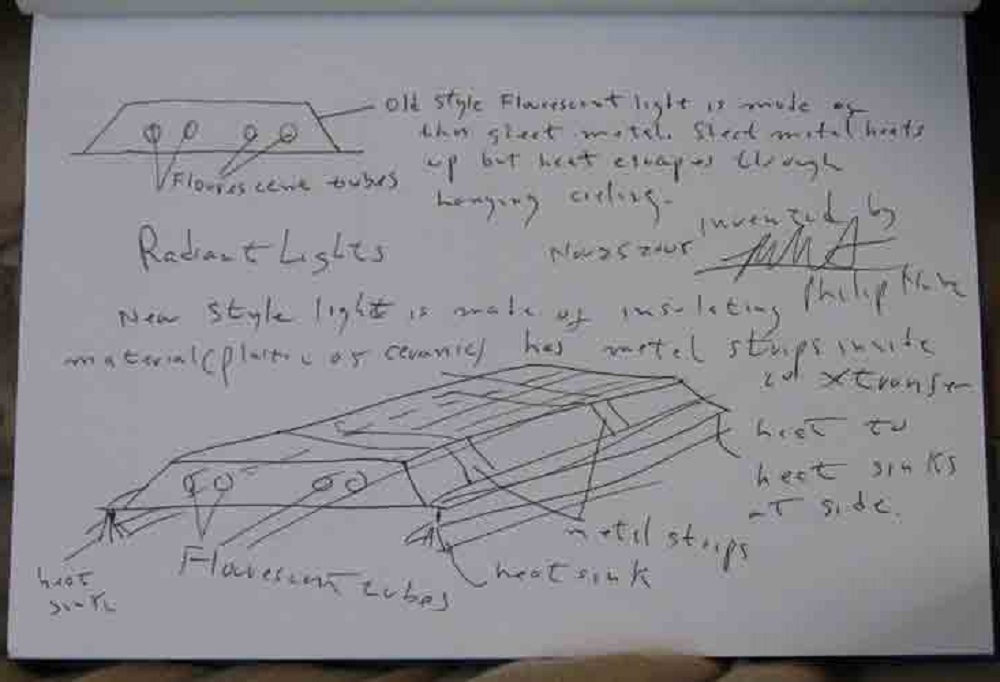
 Modular Drilling
Tunnel boring machines are the modern method for digging tunnels. I think it's possible to miniaturize tunnel boring machines for oil and gas drilling. It would eliminate the need for a drill string. It might be cheaper and be able to go further down.
Modular Drilling
Tunnel boring machines are the modern method for digging tunnels. I think it's possible to miniaturize tunnel boring machines for oil and gas drilling. It would eliminate the need for a drill string. It might be cheaper and be able to go further down.
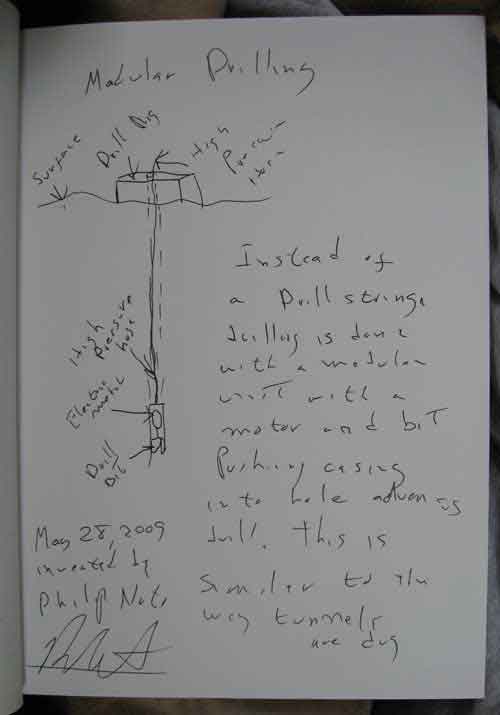 Remote Short
This idea is more like a weapon for revolutionaries. Large computer installations and communication equipment are housed in large buildings in downtown areas. The electricity that powers them run under the streets and are encased in heavy conduit. It is also very high voltage. It gets stepped down by a transformer after it enters the building. The top picture is a probe for electronics that will pierce the wire so a measurement can be made of whatever voltage exists on the wire without cutting the wire. The idea is to do this to 2 circuits outside the building and short one circuit to another and send a surge into the building. You would have to break open the conduit somehow to expose the wire. Or maybe pierce the conduit with the wire. It can be activated remotely after it is in place.
Remote Short
This idea is more like a weapon for revolutionaries. Large computer installations and communication equipment are housed in large buildings in downtown areas. The electricity that powers them run under the streets and are encased in heavy conduit. It is also very high voltage. It gets stepped down by a transformer after it enters the building. The top picture is a probe for electronics that will pierce the wire so a measurement can be made of whatever voltage exists on the wire without cutting the wire. The idea is to do this to 2 circuits outside the building and short one circuit to another and send a surge into the building. You would have to break open the conduit somehow to expose the wire. Or maybe pierce the conduit with the wire. It can be activated remotely after it is in place.
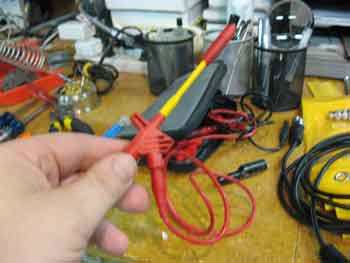
 Electric Snow Melter
This is an alternative to conventional snow plowing. In Boston a person can be fined if they don't clear the sidewalk after a snow storm. Sometimes the walk gets heavily caked with ice and becomes impossible to remove. The idea is to take a small internal combustion engine and a truck alternator and mount them on a small platform with wheels. The alternator drives an ordinary electric element that melts the ice. People who plow individual driveways could charge a little extra to clear the sidewalk. It might be possible to adapt this idea to very large trucks and replace conventional plowing altogether. It could also eliminate the need for road salt and help to clean up the water table.
Electric Snow Melter
This is an alternative to conventional snow plowing. In Boston a person can be fined if they don't clear the sidewalk after a snow storm. Sometimes the walk gets heavily caked with ice and becomes impossible to remove. The idea is to take a small internal combustion engine and a truck alternator and mount them on a small platform with wheels. The alternator drives an ordinary electric element that melts the ice. People who plow individual driveways could charge a little extra to clear the sidewalk. It might be possible to adapt this idea to very large trucks and replace conventional plowing altogether. It could also eliminate the need for road salt and help to clean up the water table.

 Anti-Aircraft
RADAR as a technology was in it’s infancy during WWII. I’m pretty sure both sides had it. One of the early defenses against RADAR was chaff. More than one bomber would go on a mission. They would fly in formation. Some would drop chaff, millions of tiny pieces in aluminum. The idea was it would reflect the RADAR and disguise the actual plane. I don’t know if they still do this. During WWII bombers were powered by propellers not jet engines. I think (I’m not sure) that if a jet engine sucked in a lot of aluminum it wouldn’t last long. Why don’t people come up with a rocket that disperses millions of pieces of aluminum as a way to knock down large airplanes? A piece the size of a soda can would certainly do damage.
Helicopters could be a problem. Instead of manned anti-aircraft I think it’s possible to design a gun that will produce a wall of bullets by simply motioning up and down a tiny amount. No need to go left and right. Trigger the gun as helicopters approach and wait for them to fly through the wall. These could be hidden on hillsides between trees and triggered automatically and would cut through whatever leaves and twigs are in the way in seconds. Someone would have to be nearby but doesn't have to actually man and aim it.
Addendum
I have been thinking about this a little more. The tiny pieces of aluminum used against RADAR is called 'chaff' not 'flak'. Flak is an airborne fragmentation grenade. The idea would be to combine the two weapons to bring down airplanes. I have seen news reports of airliners crashing because the jet engines sucked in birds while taking off or landing. WWII planes had propellers driven by internal combustion engines not jets. This idea wouldn't work on plane's with internal combustion engines. I think, I don't know, that many helicopters also have jets not internal combustion. I watched a video of the US Navy launching chaff on youtube. It looked like a cardboard tube stuffed with little pieces of metal. A fragmenattion grenade breaks into thousands of pieces when it explodes. Each piece can kill someone. If you cut up soda cans and stacked them together in a tube and launched it into the path of a plane taking off or landing you might destroy it.
Anti-Aircraft
RADAR as a technology was in it’s infancy during WWII. I’m pretty sure both sides had it. One of the early defenses against RADAR was chaff. More than one bomber would go on a mission. They would fly in formation. Some would drop chaff, millions of tiny pieces in aluminum. The idea was it would reflect the RADAR and disguise the actual plane. I don’t know if they still do this. During WWII bombers were powered by propellers not jet engines. I think (I’m not sure) that if a jet engine sucked in a lot of aluminum it wouldn’t last long. Why don’t people come up with a rocket that disperses millions of pieces of aluminum as a way to knock down large airplanes? A piece the size of a soda can would certainly do damage.
Helicopters could be a problem. Instead of manned anti-aircraft I think it’s possible to design a gun that will produce a wall of bullets by simply motioning up and down a tiny amount. No need to go left and right. Trigger the gun as helicopters approach and wait for them to fly through the wall. These could be hidden on hillsides between trees and triggered automatically and would cut through whatever leaves and twigs are in the way in seconds. Someone would have to be nearby but doesn't have to actually man and aim it.
Addendum
I have been thinking about this a little more. The tiny pieces of aluminum used against RADAR is called 'chaff' not 'flak'. Flak is an airborne fragmentation grenade. The idea would be to combine the two weapons to bring down airplanes. I have seen news reports of airliners crashing because the jet engines sucked in birds while taking off or landing. WWII planes had propellers driven by internal combustion engines not jets. This idea wouldn't work on plane's with internal combustion engines. I think, I don't know, that many helicopters also have jets not internal combustion. I watched a video of the US Navy launching chaff on youtube. It looked like a cardboard tube stuffed with little pieces of metal. A fragmenattion grenade breaks into thousands of pieces when it explodes. Each piece can kill someone. If you cut up soda cans and stacked them together in a tube and launched it into the path of a plane taking off or landing you might destroy it.
 I’ve been thinking a lot about anti aircraft and trying to neutralize helicopters. One summer when I was a kid all the kids in the neighborhood had this think going. Everybody got a piece of pipe about 12 inches long with a diameter of about 1/4 inch. We put a piece of tape around one end to put our mouth on. We went to the store and got a bag of peas. You put a dozen peas or so in your mouth and shoot them at each other like a blow gun. We had whole wars going. The next spring peas sprung up all over the neighborhood. As a kid I always wanted a BB gun but never got one. This idea combines air rifles with peas (BB’s). Helicopters fly relatively low so flak doesn’t have to get that high. You could make an anti aircraft gun with an air compressor and a solar panel that shots a type of mini ball like they used during the Civil War. Mini balls would be easier to manufacture because you wouldn’t need explosive. You shoot it with air. You could just fill up a container attached to the gun and it would load automatically. The solar panel would keep the air compressor going. No one would have to man it. The barrel wouldn’t get as hot and maybe last longer. Maybe you could fashion some type of heat sink for the barrel. It wouldn’t make as much noise as a conventional gun and might be harder to spot from the air.
The main stream media’s narrative on how the Russians were driven from Afghanistan has never changed. The CIA armed the Mujahadeen with Stinger missiles and the Russians lost control over the air space. Hollywood made a movie “Charlie Wilson's War” about a congressman who helped. This is why I’ve been thinking so much about anti aircraft. This is another installment. Yesterday I proposed a high power air driven ‘pellet gun and a few days ago I proposed making planes and helicopters fly through pieces of aluminum. This idea combines the two. A rocket could be powered by air pressure. Put the aluminum on the rocket. If you try to get a B-52 as it’s landing or taking off the rocket wouldn’t have to get very high or go very far. Air pressure would be enough.
Addendum
While soda cans are easily obtained, if you have access to a home improvement store and a little money this might be a better idea. Aluminum flashing can be bought at any home improvement store. It comes in a long roll maybe 24 inches wide by 50 ft long for about $100. The idea is to cut pieces into the shape of an ‘X’ and stack them in a cardboard tube. Each piece will act like a helicopter when released, and hang in the air for a long time giving the plane time to fly into it.
I’ve been thinking a lot about anti aircraft and trying to neutralize helicopters. One summer when I was a kid all the kids in the neighborhood had this think going. Everybody got a piece of pipe about 12 inches long with a diameter of about 1/4 inch. We put a piece of tape around one end to put our mouth on. We went to the store and got a bag of peas. You put a dozen peas or so in your mouth and shoot them at each other like a blow gun. We had whole wars going. The next spring peas sprung up all over the neighborhood. As a kid I always wanted a BB gun but never got one. This idea combines air rifles with peas (BB’s). Helicopters fly relatively low so flak doesn’t have to get that high. You could make an anti aircraft gun with an air compressor and a solar panel that shots a type of mini ball like they used during the Civil War. Mini balls would be easier to manufacture because you wouldn’t need explosive. You shoot it with air. You could just fill up a container attached to the gun and it would load automatically. The solar panel would keep the air compressor going. No one would have to man it. The barrel wouldn’t get as hot and maybe last longer. Maybe you could fashion some type of heat sink for the barrel. It wouldn’t make as much noise as a conventional gun and might be harder to spot from the air.
The main stream media’s narrative on how the Russians were driven from Afghanistan has never changed. The CIA armed the Mujahadeen with Stinger missiles and the Russians lost control over the air space. Hollywood made a movie “Charlie Wilson's War” about a congressman who helped. This is why I’ve been thinking so much about anti aircraft. This is another installment. Yesterday I proposed a high power air driven ‘pellet gun and a few days ago I proposed making planes and helicopters fly through pieces of aluminum. This idea combines the two. A rocket could be powered by air pressure. Put the aluminum on the rocket. If you try to get a B-52 as it’s landing or taking off the rocket wouldn’t have to get very high or go very far. Air pressure would be enough.
Addendum
While soda cans are easily obtained, if you have access to a home improvement store and a little money this might be a better idea. Aluminum flashing can be bought at any home improvement store. It comes in a long roll maybe 24 inches wide by 50 ft long for about $100. The idea is to cut pieces into the shape of an ‘X’ and stack them in a cardboard tube. Each piece will act like a helicopter when released, and hang in the air for a long time giving the plane time to fly into it.
 No one can hold a piece of territory without controlling the air space above it. Air bombing and helicopters are 2 modern weapons that allow the global elite to hold power. Counter measures can be expensive and complicated. Heat seeking missiles are expensive and so are anti-aircraft guns. This is 2 ideas that are less expensive.
Flak was used by the Germans during WWII. Flak is basically an airborne fragmentation grenade. It is aimed at maiming the people on board the plane. When it gets close to the plane it goes off and fragments into thousands of pieces each of which is a bullet capable of injuring someone. It easily penetrates the outer surface of the plane. Planes must be as light as possible so the covering of the fuselage is thin. WWII planes had internal combustion engines not jets. (also called turbines) They were capable of surviving flak better the turbines. A turbine sucks in outer air, compresses it, adds fuel and ignites it to create thrust. Anything sucked into the turbine like metal will destroy it. Many commercial airliners have been brought down by birds sucked into the engine on takeoff or landing.
Chaff is used to confuse RADAR. Chaff is thousands of little pieces of aluminum spread over a wide area. If the pieces are large enough they could be sucked into a turbine and cause it to fail. Ordinary soda cans could be cut up and packed into cardboard tubes with explosive in the middle. It could be launched with compressed air if the tube isn’t going that far. That is, it was deployed during takeoff or landing. Compressed air could be used with flak. Helicopters also use turbines. They do not fly at high altitudes most of the time. Certainly not while attacking.
Another vulnerability with helicopters are the blades. Automobile tires must be balanced or the car will vibrate violently. They spin so fast that even the smallest difference in weight will cause this. Helicopter blades are the same. They must be perfectly balanced. A way to take down a helicopter might be to damage 1 or 2 of the blades and throw them out of balance. If the blades hit something while in flight it might damage it and throw it out of balance. You could hang a piece of steel from chaff and have the helicopter fly into it.
If personnel on the ground know an aircraft is present without being detected they have the element of surprise. RADAR was developed in the 1930's to pick up aircraft from the ground. RADAR sends a very high power microwave signal into the air and then picks up anything that bounces off an airplane. It is literally broadcasting it's presence and location. RADAR can be picked up by the aircraft and steps can be taken to neutralize the RADAR equipment. Great strides have been made in electronics since the 1930's. There are now transducers for almost any type of phenomena. Light, vibration, heat, etc etc. Many of these are used in satellites. If they can be used to sense something on the ground from that far away why not from the ground to the air. If an anti-aircraft installation was based on sensing technology instead of RADAR it would be harder for the enemy to pick up and destroy. The installation could be small and portable. Two transducers that could be used are infrared C.C.D. (charge coupled device) and vibration. Airplanes, including helicopters and drones, produce heat and vibration. A C.C.D. is used in almost every digital camera. An infrared C.C.D. could be attached to a high power wide angle lens and monitored with a computer screen. A separate vibration sensor could be used to guide any missile used to take down the airplane. A directed beam of microwaves might be used to scramble the avionics of the plane.
NASA Remote Sensing Tutorial pdf
Neutralizing Satellites
Proof that this can be done. This happened in Florida. I'm pretty sure. Maybe the 1980's. A couple hackers broke into a satellite TV feed and put their programming into thousands of homes. Suffice it to say they got caught and ended up in jail. Their programming was very inappropriate, but that's not what got busted. It was the fact they did it. Satellites like everything else operate with software. They way to a satellites heart is through the software. If you could mess up a mainframe somehow, why not a satellite?
Satellites run on solar voltaic arrays. It might be possible to destroy the solar cells with a high power LASER based on the ground.
Satellites are useless if you can't communicate with them. Establish a connection then turn up the power and try to destroy the circuitry associated with the antenna.
Nikola Tesla
Nikola Tesla is credited with inventing most of the technology behind the power grid. He favored the AC (alternating current) system over Thomas Edisons DC (direct current) system. There are stories on the internet that Tesla had invented an automobile that ran without gas. When you create current in a conductor you also create Eddy waves around the wire. You can measure these with an AC clamp meter. The meter is basically a transformer that measures the strength of the Eddy waves. Eddy waves have 2 components. An electric component and a magnetic component. You can’t induce a current into a coil without both components. The earth has a natural magnetic field around it. A compass operates by employing it. Light is basically electricity at very high frequencies but has both components. Did Tesla come up with a way to harness the earths natural magnetic field and some natural electric field and produce mechanical motion?
----------------------------------------------------------------------------------------------------------------
Updated August 21 2017
All My Inventions In One PDF
No one can hold a piece of territory without controlling the air space above it. Air bombing and helicopters are 2 modern weapons that allow the global elite to hold power. Counter measures can be expensive and complicated. Heat seeking missiles are expensive and so are anti-aircraft guns. This is 2 ideas that are less expensive.
Flak was used by the Germans during WWII. Flak is basically an airborne fragmentation grenade. It is aimed at maiming the people on board the plane. When it gets close to the plane it goes off and fragments into thousands of pieces each of which is a bullet capable of injuring someone. It easily penetrates the outer surface of the plane. Planes must be as light as possible so the covering of the fuselage is thin. WWII planes had internal combustion engines not jets. (also called turbines) They were capable of surviving flak better the turbines. A turbine sucks in outer air, compresses it, adds fuel and ignites it to create thrust. Anything sucked into the turbine like metal will destroy it. Many commercial airliners have been brought down by birds sucked into the engine on takeoff or landing.
Chaff is used to confuse RADAR. Chaff is thousands of little pieces of aluminum spread over a wide area. If the pieces are large enough they could be sucked into a turbine and cause it to fail. Ordinary soda cans could be cut up and packed into cardboard tubes with explosive in the middle. It could be launched with compressed air if the tube isn’t going that far. That is, it was deployed during takeoff or landing. Compressed air could be used with flak. Helicopters also use turbines. They do not fly at high altitudes most of the time. Certainly not while attacking.
Another vulnerability with helicopters are the blades. Automobile tires must be balanced or the car will vibrate violently. They spin so fast that even the smallest difference in weight will cause this. Helicopter blades are the same. They must be perfectly balanced. A way to take down a helicopter might be to damage 1 or 2 of the blades and throw them out of balance. If the blades hit something while in flight it might damage it and throw it out of balance. You could hang a piece of steel from chaff and have the helicopter fly into it.
If personnel on the ground know an aircraft is present without being detected they have the element of surprise. RADAR was developed in the 1930's to pick up aircraft from the ground. RADAR sends a very high power microwave signal into the air and then picks up anything that bounces off an airplane. It is literally broadcasting it's presence and location. RADAR can be picked up by the aircraft and steps can be taken to neutralize the RADAR equipment. Great strides have been made in electronics since the 1930's. There are now transducers for almost any type of phenomena. Light, vibration, heat, etc etc. Many of these are used in satellites. If they can be used to sense something on the ground from that far away why not from the ground to the air. If an anti-aircraft installation was based on sensing technology instead of RADAR it would be harder for the enemy to pick up and destroy. The installation could be small and portable. Two transducers that could be used are infrared C.C.D. (charge coupled device) and vibration. Airplanes, including helicopters and drones, produce heat and vibration. A C.C.D. is used in almost every digital camera. An infrared C.C.D. could be attached to a high power wide angle lens and monitored with a computer screen. A separate vibration sensor could be used to guide any missile used to take down the airplane. A directed beam of microwaves might be used to scramble the avionics of the plane.
NASA Remote Sensing Tutorial pdf
Neutralizing Satellites
Proof that this can be done. This happened in Florida. I'm pretty sure. Maybe the 1980's. A couple hackers broke into a satellite TV feed and put their programming into thousands of homes. Suffice it to say they got caught and ended up in jail. Their programming was very inappropriate, but that's not what got busted. It was the fact they did it. Satellites like everything else operate with software. They way to a satellites heart is through the software. If you could mess up a mainframe somehow, why not a satellite?
Satellites run on solar voltaic arrays. It might be possible to destroy the solar cells with a high power LASER based on the ground.
Satellites are useless if you can't communicate with them. Establish a connection then turn up the power and try to destroy the circuitry associated with the antenna.
Nikola Tesla
Nikola Tesla is credited with inventing most of the technology behind the power grid. He favored the AC (alternating current) system over Thomas Edisons DC (direct current) system. There are stories on the internet that Tesla had invented an automobile that ran without gas. When you create current in a conductor you also create Eddy waves around the wire. You can measure these with an AC clamp meter. The meter is basically a transformer that measures the strength of the Eddy waves. Eddy waves have 2 components. An electric component and a magnetic component. You can’t induce a current into a coil without both components. The earth has a natural magnetic field around it. A compass operates by employing it. Light is basically electricity at very high frequencies but has both components. Did Tesla come up with a way to harness the earths natural magnetic field and some natural electric field and produce mechanical motion?
----------------------------------------------------------------------------------------------------------------
Updated August 21 2017
All My Inventions In One PDF
Updated April 3 2017 On Feb 20 I proposed my idea for EMI absorbent material. I have come up with a couple other ideas for it. I have re-posted the Feb 20 below then presented the new ideas. EMI absorbent material could be used in an apartment that you don't own. You might not have access to the earth ground or someone could mess with it.
I have been thinking about electro-magnetic absorbent material. (EMI) I watched “The Graduate” over the weekend. It has the Simon and Garfunkel song “The Sound Of Silence”. They play it when he’s in the SCUBA gear. (self-contained underwater breathing apparatus) Supposedly the HAARP facility in Alaska is for communicating with submarines. All this makes me think. A tin foil hat won’t work because it isn’t connected to earth ground. Without that connection only the reflectance properties of the metal would apply. Reflectance is only a fraction of what it encounters. Some sort of EMI absorbent material would be better. They do make it. I don’t know how it works. This is my version. (see picture below) Come up with some way to spin millions of micro sized bare silver wire into a resistive material. Each piece of wire would act as the schematic below. A current (I) would be induced and then burnt as heat by the resistor. If necessary 2 (or more) layers could be made for different frequency ranges. The top layer for microwave communication and the bottom layer for the frequencies produced by the human brain.
The top 2 pictures involve the first idea. It's a sort of home brew EMI absorbent. Get some 1/4 watt resistors and wrap the ends around the body of the resistor (top picture). This creates the equivilent circuit shown. Current is induced in the coil and burned as heat in the resistor. Another method would be to wrap some 30 gauge or 32 gauge wire, if they make it, around the resistor instead of the 2 ends. Then glue them to a substrate to cover the entire surface. (second picture) Paste the substrate to the ceilings and walls.
This idea is more complicated and would require building some kind of manufacturing equipment. I think you could look up patents in the patent office online on how screen for windows and doors is made and copy that. It might be some sort of weaving process. The idea is to make screen that is half nylon and half aluminum. All the nylon would go one way, either horizontal or vertical, and the aluminum the other way. Every 6 inches or so connect a resistor across 2 of the aluminum strands. Keep each pair of aluminum strands separate from each other. The patent office could be used for all kinds of ways to fight back.
This idea expands the necklace that jams your personal emissions. Come up with a circuit that produces an artificial audio/voice signal. ?? Combine amplitude and frequency modulation in combination with some oscillators ???, then use a voice scrambler circuit to make noise. Put that signal on the necklace.

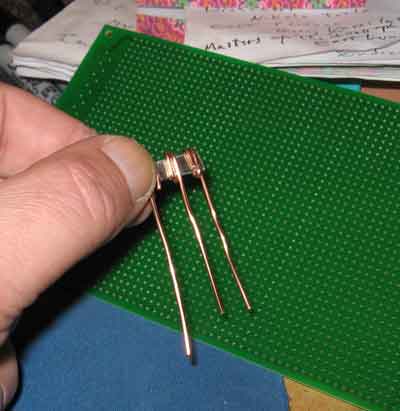
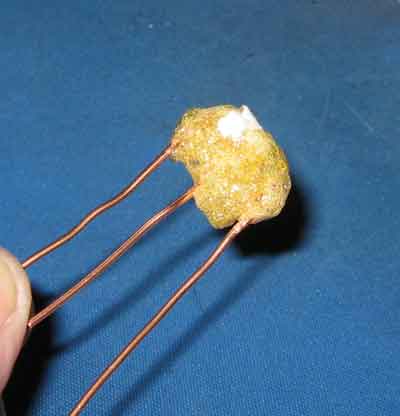 The next picture is a schematic. The componant is in series with a resistor from power to ground. Some sort of oscillator is connected between the resistor and componant. The output is connected to a capacitor to remove any DC voltage. The noise is then amplified and split into more than one signal. The separated signals are conditioned further. One could be phase shifted, another could be inverted etc. Then those signals are recombined in a mixer to make really intense noise.
The next picture is a schematic. The componant is in series with a resistor from power to ground. Some sort of oscillator is connected between the resistor and componant. The output is connected to a capacitor to remove any DC voltage. The noise is then amplified and split into more than one signal. The separated signals are conditioned further. One could be phase shifted, another could be inverted etc. Then those signals are recombined in a mixer to make really intense noise.
 I think it was John von Neumann who said "Anyone who designs a truly random digital circuit is committing a sin". This is what he may have meant. The human body produces hundreds or maybe even thousands of different electric signals of different frequencies, voltage levels and duration. To reconstruct a persons thoughts or sub-vocal speech you would have to sort through all those signals without making a physical connection. You would have to pick up all the signals with an antenna and use a computer to pick out the ones you need. To do that you need to convert analog signals to digital information. A/D converters would be installed after the antenna. Computer software would be used to sort by frequency, voltage, power, etc. If you came up with an analog noise signal that covered the entire range of what the human body emits and it was totally random the computer A/D converters would produce a totally random sequence of digital information. They would have to apply an analog filter that would also filter out what they are looking for. I have a book titled "Modern Communication Jamming: Principles and Techniques" by Richard A. Poisel. In it he decribes how most electric noise can be reduced to some sort of mathematical equation. Anything but completely random noise can be 'filtered' with software if it has a mathematical equation. Truly random noise would not have a equation.
This is a couple other ideas I have been thinking about for a long time. On farms where animals are bred for slaughter they produce a lot of urine. Disposing of it can be a problem. The idea is to collect it in a large container and boil it with an electric heat element attached to photo voltaic panels. Release the steam into the atmosphere.
This is an idea for budding revolutionary's. Modern army's are heavily dependent on technology. Electronics is a major force in warfare and it's cost is prohibitive to people at the bottom trying to fight back. This idea might help reduce the cost of experimenting and building technology. When I first started in electronics printed circuit boards (PCB) were assembled with parts that were called 'through hole'. The leads of the various parts were put through a hole in the PCB and soldered on the opposite side. There was a componant side and a solder side. Getting parts in and out of the PCB was difficult. Today almost everything is surface mount technology (SMT). The parts are soldered on the componant side. While hobbyists have found it difficult to work and experiment with SMT it can be done. I think getting the parts off the PCB could be fairly simple. I worked for a time for a company that made equipment that measured and delivered materials. Two methods were a conveyor belt and what they called 'loss of weight' (LOW). The LOW had 2 ways to accomplish the delivery. Screw and vibratory. The vibratory used a small vibrating device attached to a metal tray placed at an angle. The vibration moved the material along. The actual vibrating device was purchased outside the company. I don't remember what the name was. They could be very small or very large. It worked by some type of transformer principle. The idea is this. Build a small enclosure 20 inches by 20 inches by 10 inches tall that will withstand high heat. Place a very small vibratory unit in the bottom that can be adjusted for small vibration or large. Above the vibratory, in the middle of the enclosure, place some rubber at a steep angle. Attach to the vibratory, above the rubber and at a steep angle, a harness that will hold the PCB being stripped of componants upside down. Place a heating element in the upper part of the enclosure that will heat the entire space enough to melt electric solder. As the temperature of the enclosure rises the PCB is vibrated and the parts fall in the rubber along with residual solder. The only parts of any real value are the largest IC's. Part of the harness holding the PCB should have a cage of plastic to separate the large parts from the small and remove the residual solder. (see picture)
Once the PCB has had all the parts removed it's not worth anything except for the metal. I think it's possible to separate and recover some of the metal. Build an enclosure with a grinding wheel that is airtight. Automatically feed the PCB into the grinding wheel turning it to dust. Blow the dust into another enclosure where a gas flame burns away the fiberglass in the dust. Collect the metal. Build an enclosure with a crucible attached to a vibratory and put the remaining dust in the crucible. Different metals have different melting points. Slowly raise the temperature until the first melting point is reached. Vibrate the crucible to help whatever metal is in the dust bead together. Remove the heat, open the enclosure, and remove what metal has collected and repeat the process at the next highest temperature. (see picture)
Updated May 17 2016
I think it was John von Neumann who said "Anyone who designs a truly random digital circuit is committing a sin". This is what he may have meant. The human body produces hundreds or maybe even thousands of different electric signals of different frequencies, voltage levels and duration. To reconstruct a persons thoughts or sub-vocal speech you would have to sort through all those signals without making a physical connection. You would have to pick up all the signals with an antenna and use a computer to pick out the ones you need. To do that you need to convert analog signals to digital information. A/D converters would be installed after the antenna. Computer software would be used to sort by frequency, voltage, power, etc. If you came up with an analog noise signal that covered the entire range of what the human body emits and it was totally random the computer A/D converters would produce a totally random sequence of digital information. They would have to apply an analog filter that would also filter out what they are looking for. I have a book titled "Modern Communication Jamming: Principles and Techniques" by Richard A. Poisel. In it he decribes how most electric noise can be reduced to some sort of mathematical equation. Anything but completely random noise can be 'filtered' with software if it has a mathematical equation. Truly random noise would not have a equation.
This is a couple other ideas I have been thinking about for a long time. On farms where animals are bred for slaughter they produce a lot of urine. Disposing of it can be a problem. The idea is to collect it in a large container and boil it with an electric heat element attached to photo voltaic panels. Release the steam into the atmosphere.
This is an idea for budding revolutionary's. Modern army's are heavily dependent on technology. Electronics is a major force in warfare and it's cost is prohibitive to people at the bottom trying to fight back. This idea might help reduce the cost of experimenting and building technology. When I first started in electronics printed circuit boards (PCB) were assembled with parts that were called 'through hole'. The leads of the various parts were put through a hole in the PCB and soldered on the opposite side. There was a componant side and a solder side. Getting parts in and out of the PCB was difficult. Today almost everything is surface mount technology (SMT). The parts are soldered on the componant side. While hobbyists have found it difficult to work and experiment with SMT it can be done. I think getting the parts off the PCB could be fairly simple. I worked for a time for a company that made equipment that measured and delivered materials. Two methods were a conveyor belt and what they called 'loss of weight' (LOW). The LOW had 2 ways to accomplish the delivery. Screw and vibratory. The vibratory used a small vibrating device attached to a metal tray placed at an angle. The vibration moved the material along. The actual vibrating device was purchased outside the company. I don't remember what the name was. They could be very small or very large. It worked by some type of transformer principle. The idea is this. Build a small enclosure 20 inches by 20 inches by 10 inches tall that will withstand high heat. Place a very small vibratory unit in the bottom that can be adjusted for small vibration or large. Above the vibratory, in the middle of the enclosure, place some rubber at a steep angle. Attach to the vibratory, above the rubber and at a steep angle, a harness that will hold the PCB being stripped of componants upside down. Place a heating element in the upper part of the enclosure that will heat the entire space enough to melt electric solder. As the temperature of the enclosure rises the PCB is vibrated and the parts fall in the rubber along with residual solder. The only parts of any real value are the largest IC's. Part of the harness holding the PCB should have a cage of plastic to separate the large parts from the small and remove the residual solder. (see picture)
Once the PCB has had all the parts removed it's not worth anything except for the metal. I think it's possible to separate and recover some of the metal. Build an enclosure with a grinding wheel that is airtight. Automatically feed the PCB into the grinding wheel turning it to dust. Blow the dust into another enclosure where a gas flame burns away the fiberglass in the dust. Collect the metal. Build an enclosure with a crucible attached to a vibratory and put the remaining dust in the crucible. Different metals have different melting points. Slowly raise the temperature until the first melting point is reached. Vibrate the crucible to help whatever metal is in the dust bead together. Remove the heat, open the enclosure, and remove what metal has collected and repeat the process at the next highest temperature. (see picture)
Updated May 17 2016
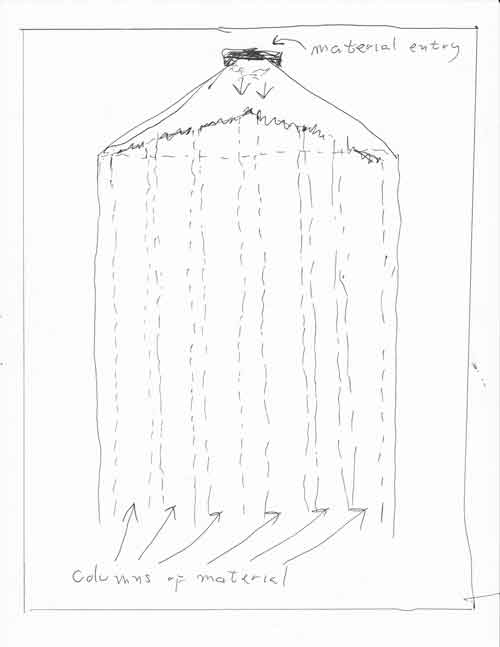
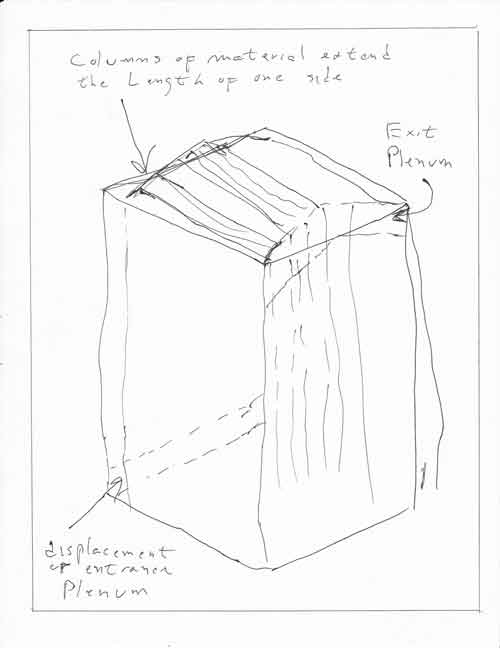
 This post updates the Methane Silo. The silo would be square. The columns of material would extend the length of one side. The ends of the columns would face 2 sides opposite each other. The top would be shaped like a roof so the material would distribute evenly down each column. The entire space containing the material would be airtight. A plenum would be placed at the 2 ends facing all columns. One plenum at the bottom and the other at the top. The bottom plenum would allow air in when methane is being withdrawn from the top. There would be a series of valves controlled by electronics. Once material has completely filled the airtight space, a vacumm pump creates a vacumm. As methane is produced pressure builds up. When it gets high enough valves on both plenums open and remove methane. When pressure drops, the valves close and the vacumm pump creates another vacumm. This process concentrates the methane and reduces the amount of unwanted gas (air) in the final product.
Added April 9, 2016 The transistor was invented about 1948. It is a PN junction of silicon. They can put millions of transistors on a single chip. When they first started doing this they called it Small Scale Integration (SSI). Soon after they introduced Large Scale Integration (LSI) after that came Very Large Scale Integration (VLSI). Today they can pack billions of PN junctions in a square inch. An Intel Pentium CPU for example. A solar voltiac cell is made up of PN junctions that convert light to electricity. Question of the day. Have they ever applied VLSI technology to the making of solar voltaic cells? Would this make them more sensitive? Doing this would challenge the power of the oil industry. Maybe thats why it never happened.
This page is some of my inventions. Some might be original some not. I begin with some of my ideas on solar energy. Peak Oil is something even oil industry experts agree is a problem. Peak Oil is the concept where we have reached the maximun rate at which oil can be found, brought to the surface and delivered to market. We currently consume approx. 80 million barrels a day worldwide. They agree it can't go any higher. It took man about one hundred years to reach that. It might take one hundred years to run out at current population levels. They say the 80 million barrel number will begin to decline and never recover. Man's food supply, like everything else, is now heavily dependent on oil. Too much of our food production is in the hands of too few people as a result of capitalism. I have heard figures that state we use 10 joules of energy (fossil fuels) for every one calorie of food we produce. Prior to the industrial revolution that figure was 0. The average person needs 2000 calories per day. Our food supply can be used as a weapon. Solar energy can be an alternative. It has an advantage that to many may seem a drawback. It can't fuel large factories or buildings. To me this is a plus. It would help keep business's small and help stop the concentration of wealth.
Solar panels convert sunlight to DC electric current with semiconductor technology. They use the same PN junction used in every transistor. Silicon transistors can make light. It's called an LED. (Light Emitting Diode) So it can both make electricity from light and make light from electricity. Thats about as much as I know.
There are 3 types of solar panels. Amorphous, poly-crystalline and mono-crystalline. Amorphous are the least sensitive and cheapest. Poly-crystalline are in the middle and mono-crystalline are the most sensitive and costly. Amorphous are best used near the equator where there is abundant direct sunlight. They don't work very well near the poles. (north and south) It is best to use the most sensitive where the sunlight is not as direct.
The picture below shows 6 panels. This might be 1000 watts on a very sunny day. To help you understand, a desktop personal computer would be a constant 600 watts. A laptop or notebook less. A microwave oven is typically 1200 watts. You can't use them at night unless you store the energy somehow. There are at least two ways to produce the electricity at a later time. One is batteries and the other is with a fuel cell. (see second picture below) A fuel cell combines hydrogen and oxygen to make electricity and you get water as a by-product. Since solar panels make DC current it can be used to seperate hydrogen and oxygen with a process known as electrolysis. The 2 componants can be generated during the day and stored in 2 seperate containers and then recombined at night. The third picture below is a small desktop seperator.
This post updates the Methane Silo. The silo would be square. The columns of material would extend the length of one side. The ends of the columns would face 2 sides opposite each other. The top would be shaped like a roof so the material would distribute evenly down each column. The entire space containing the material would be airtight. A plenum would be placed at the 2 ends facing all columns. One plenum at the bottom and the other at the top. The bottom plenum would allow air in when methane is being withdrawn from the top. There would be a series of valves controlled by electronics. Once material has completely filled the airtight space, a vacumm pump creates a vacumm. As methane is produced pressure builds up. When it gets high enough valves on both plenums open and remove methane. When pressure drops, the valves close and the vacumm pump creates another vacumm. This process concentrates the methane and reduces the amount of unwanted gas (air) in the final product.
Added April 9, 2016 The transistor was invented about 1948. It is a PN junction of silicon. They can put millions of transistors on a single chip. When they first started doing this they called it Small Scale Integration (SSI). Soon after they introduced Large Scale Integration (LSI) after that came Very Large Scale Integration (VLSI). Today they can pack billions of PN junctions in a square inch. An Intel Pentium CPU for example. A solar voltiac cell is made up of PN junctions that convert light to electricity. Question of the day. Have they ever applied VLSI technology to the making of solar voltaic cells? Would this make them more sensitive? Doing this would challenge the power of the oil industry. Maybe thats why it never happened.
This page is some of my inventions. Some might be original some not. I begin with some of my ideas on solar energy. Peak Oil is something even oil industry experts agree is a problem. Peak Oil is the concept where we have reached the maximun rate at which oil can be found, brought to the surface and delivered to market. We currently consume approx. 80 million barrels a day worldwide. They agree it can't go any higher. It took man about one hundred years to reach that. It might take one hundred years to run out at current population levels. They say the 80 million barrel number will begin to decline and never recover. Man's food supply, like everything else, is now heavily dependent on oil. Too much of our food production is in the hands of too few people as a result of capitalism. I have heard figures that state we use 10 joules of energy (fossil fuels) for every one calorie of food we produce. Prior to the industrial revolution that figure was 0. The average person needs 2000 calories per day. Our food supply can be used as a weapon. Solar energy can be an alternative. It has an advantage that to many may seem a drawback. It can't fuel large factories or buildings. To me this is a plus. It would help keep business's small and help stop the concentration of wealth.
Solar panels convert sunlight to DC electric current with semiconductor technology. They use the same PN junction used in every transistor. Silicon transistors can make light. It's called an LED. (Light Emitting Diode) So it can both make electricity from light and make light from electricity. Thats about as much as I know.
There are 3 types of solar panels. Amorphous, poly-crystalline and mono-crystalline. Amorphous are the least sensitive and cheapest. Poly-crystalline are in the middle and mono-crystalline are the most sensitive and costly. Amorphous are best used near the equator where there is abundant direct sunlight. They don't work very well near the poles. (north and south) It is best to use the most sensitive where the sunlight is not as direct.
The picture below shows 6 panels. This might be 1000 watts on a very sunny day. To help you understand, a desktop personal computer would be a constant 600 watts. A laptop or notebook less. A microwave oven is typically 1200 watts. You can't use them at night unless you store the energy somehow. There are at least two ways to produce the electricity at a later time. One is batteries and the other is with a fuel cell. (see second picture below) A fuel cell combines hydrogen and oxygen to make electricity and you get water as a by-product. Since solar panels make DC current it can be used to seperate hydrogen and oxygen with a process known as electrolysis. The 2 componants can be generated during the day and stored in 2 seperate containers and then recombined at night. The third picture below is a small desktop seperator.


 Another problem with solar panels is snow. Snow would cover the panel and prevent light from getting through. There are ways to solve this. A car rear window de-fogger uses small amounts of electricity to melt ice on your car. It's something like an electric stove. It has small lines of a resistive substance that heat up when current is passed through. If solar panels are kept very thin they could be put on the bottom so as not to stop sunlight. Panels could be made as small as possible. Instead of 6 panels 3 feet by 6 feet you could make 18 panels 1 foot by 1 foot. Raise the panels up off the roof and seperate them by a couple inches to allow water to fall off. Making them smaller can also help if one goes bad. Replacing a 6 by 3 would be more expensive than a 1 by 1.
Solar voltaic panels can be used to heat a home as well. The top picture below is an electric stove top. It glows red when electricity flows through it. The bottom picture is a possible application. The idea is to wrap the element around a piece of pipe and send water through the pipe so it picks up the heat. Two things could be done. One is to preheat an existing fossil fuel heating system (oil, natural gas etc) by placing the pipe in-line with the zones of the house. The furnace would not stay on as long or maybe not come on at all. This would cut down on the amount of fossil fuel used and it could also be an incentive for people to purchase photo voltaic panels while the technology is improved. Another use would be putting a unit right where hot water is needed like the kitchen or bathroom. This would cut down on the amount of piping needed and eliminate the need for a hot water tank.
Another problem with solar panels is snow. Snow would cover the panel and prevent light from getting through. There are ways to solve this. A car rear window de-fogger uses small amounts of electricity to melt ice on your car. It's something like an electric stove. It has small lines of a resistive substance that heat up when current is passed through. If solar panels are kept very thin they could be put on the bottom so as not to stop sunlight. Panels could be made as small as possible. Instead of 6 panels 3 feet by 6 feet you could make 18 panels 1 foot by 1 foot. Raise the panels up off the roof and seperate them by a couple inches to allow water to fall off. Making them smaller can also help if one goes bad. Replacing a 6 by 3 would be more expensive than a 1 by 1.
Solar voltaic panels can be used to heat a home as well. The top picture below is an electric stove top. It glows red when electricity flows through it. The bottom picture is a possible application. The idea is to wrap the element around a piece of pipe and send water through the pipe so it picks up the heat. Two things could be done. One is to preheat an existing fossil fuel heating system (oil, natural gas etc) by placing the pipe in-line with the zones of the house. The furnace would not stay on as long or maybe not come on at all. This would cut down on the amount of fossil fuel used and it could also be an incentive for people to purchase photo voltaic panels while the technology is improved. Another use would be putting a unit right where hot water is needed like the kitchen or bathroom. This would cut down on the amount of piping needed and eliminate the need for a hot water tank.

 When central heating began in the late 19th century early 20th century it often involved keeping a fire going in the furnace all the time. Coal was delivered and the homeowner had to shovel it into the furnace. Modern furnaces turn on and turn off when needed. Keeping the fire going all the time led to overheating and it sometimes blew up. I beleive, I'm not sure, this is why you can't connect a wood burning stove to your heating system if it is forced hot water. My idea is to have a wood burning stove on the first floor of the house and have a tank in the cellar that holds water. The water would be held in a rubber bladder inside the tank. The tank is connected to a piping system that goes to the wood stove on the first floor. The piping system includes a heat exchanger that also carries the water from the furnace. When needed, a small air compressor turns on, pressurizes the tank forcing the water out of the bladder by squezzing it against the side of the tank and into the piping system. It goes through the pipe, picks up heat from the first floor stove and exchanges it in the cellar with the heating system by the exchanger thus adding BTU's to the heat and cutting down someone's heating bill. When the system is not calling the water drops out of the piping system into the bladder thus avoiding a possible explosion. Another safety factor could include some type of heat sink on the bottom of the stove that disconnects the piping system when the furnace is not calling. Both the water in the piping system and the heat sink would work on gravity.
Yard waste is plant material. Plant material can be burned if it is seperated and processed. They say money doesn't grow on trees but here in New England we get rid of tons and tons of leaves and general yard waste every year. This could all be ground up, put in a methane silo then blended and pelletized for burning in wood stoves.
This is 2 ideas to help very small business's in strip malls. For the most part strip malls are built the same across the country. Inner city and otherwise. The stores inside them are often built with a minimum of building materials to keep costs down and allow the mall owner to easily rip it out if the business fails. The roofs are well above the actual ceiling of the store and it is usually a hanging ceiling. It's just some aluminum track with light fiber panels laying on them. Often there is no insulation between the ceiling and roof so most of the heat goes out the roof and is a big waste of money. Most strip malls are heated with natural gas which is more expensive then other fuels. The first idea is to build the inside with more substantial materials so insulation can be put between the ceiling and roof. The second is radiant lights. Flourescent lights give off a tremendous amount of heat. If they were constructed with different materials the heat could be directed into the room. Instead of the entire housing being metal, most of it should be a heavy heat resistant plastic, painted white. Thin metal strips could be placed inside the housing and connected to large heat sinks on the sides. All heat would be radiated into the room by the heat sinks.
Methane Silo
Every check that goes out the door at the end of the month is another link in the ball and chain of our system. Reducing energy costs for small businesses and small business owners would do more to help the economy than one tax cut for ExxonMobil. It would help to break up these big companies. Waiting for the government to break them up is hopeless. Putting them out of business with alternative technology is more practical. It used to be that people understood that being your own boss was much better than working for a big company. There is no crime in owning a small business.
Methane Silo. Methane is a naturally occuring gas produced by the decay of organic material such as animal waste or plants. It is a fossil fuel like oil propane or butane. It can be used to produce mechanical or electrical power. It's chemical formula is CH4. One atom of carbon and 4 atoms of hydrogen. Like any gas it is best transported by pipeline or used where it is produced. Some attempts to harness methane involve laying out plant material in large sealed buildings and collecting it as the material decays. (see picture below) One problem with this is the material must be turned over every so often to help the material decay. As the material decays it gives off less and less methane. A methane silo eliminates the need to do this. A methane silo works as any silo by gravity. The material is fed into the top and comes out the bottom. The difference is a methane silo would have long tubes of screen inside the silo to help expose the material to the air to help it decay and give off methane. This eliminates the need to turn it.
When central heating began in the late 19th century early 20th century it often involved keeping a fire going in the furnace all the time. Coal was delivered and the homeowner had to shovel it into the furnace. Modern furnaces turn on and turn off when needed. Keeping the fire going all the time led to overheating and it sometimes blew up. I beleive, I'm not sure, this is why you can't connect a wood burning stove to your heating system if it is forced hot water. My idea is to have a wood burning stove on the first floor of the house and have a tank in the cellar that holds water. The water would be held in a rubber bladder inside the tank. The tank is connected to a piping system that goes to the wood stove on the first floor. The piping system includes a heat exchanger that also carries the water from the furnace. When needed, a small air compressor turns on, pressurizes the tank forcing the water out of the bladder by squezzing it against the side of the tank and into the piping system. It goes through the pipe, picks up heat from the first floor stove and exchanges it in the cellar with the heating system by the exchanger thus adding BTU's to the heat and cutting down someone's heating bill. When the system is not calling the water drops out of the piping system into the bladder thus avoiding a possible explosion. Another safety factor could include some type of heat sink on the bottom of the stove that disconnects the piping system when the furnace is not calling. Both the water in the piping system and the heat sink would work on gravity.
Yard waste is plant material. Plant material can be burned if it is seperated and processed. They say money doesn't grow on trees but here in New England we get rid of tons and tons of leaves and general yard waste every year. This could all be ground up, put in a methane silo then blended and pelletized for burning in wood stoves.
This is 2 ideas to help very small business's in strip malls. For the most part strip malls are built the same across the country. Inner city and otherwise. The stores inside them are often built with a minimum of building materials to keep costs down and allow the mall owner to easily rip it out if the business fails. The roofs are well above the actual ceiling of the store and it is usually a hanging ceiling. It's just some aluminum track with light fiber panels laying on them. Often there is no insulation between the ceiling and roof so most of the heat goes out the roof and is a big waste of money. Most strip malls are heated with natural gas which is more expensive then other fuels. The first idea is to build the inside with more substantial materials so insulation can be put between the ceiling and roof. The second is radiant lights. Flourescent lights give off a tremendous amount of heat. If they were constructed with different materials the heat could be directed into the room. Instead of the entire housing being metal, most of it should be a heavy heat resistant plastic, painted white. Thin metal strips could be placed inside the housing and connected to large heat sinks on the sides. All heat would be radiated into the room by the heat sinks.
Methane Silo
Every check that goes out the door at the end of the month is another link in the ball and chain of our system. Reducing energy costs for small businesses and small business owners would do more to help the economy than one tax cut for ExxonMobil. It would help to break up these big companies. Waiting for the government to break them up is hopeless. Putting them out of business with alternative technology is more practical. It used to be that people understood that being your own boss was much better than working for a big company. There is no crime in owning a small business.
Methane Silo. Methane is a naturally occuring gas produced by the decay of organic material such as animal waste or plants. It is a fossil fuel like oil propane or butane. It can be used to produce mechanical or electrical power. It's chemical formula is CH4. One atom of carbon and 4 atoms of hydrogen. Like any gas it is best transported by pipeline or used where it is produced. Some attempts to harness methane involve laying out plant material in large sealed buildings and collecting it as the material decays. (see picture below) One problem with this is the material must be turned over every so often to help the material decay. As the material decays it gives off less and less methane. A methane silo eliminates the need to do this. A methane silo works as any silo by gravity. The material is fed into the top and comes out the bottom. The difference is a methane silo would have long tubes of screen inside the silo to help expose the material to the air to help it decay and give off methane. This eliminates the need to turn it.

 Two Improved PCB Processes
The old way of making blank printed circuit boards require alot of chemicals and machinery. Chemicals include acids, electroplating solutions and photoresist. The processes include photography, ultraviolet light, etching with acids, drilling holes, and electroplating. It's dirty, time consuming and inexact. Componants must be added later with different machines. Many of the chemicals are oil based. It is very labor intensive. Companies sometimes employ hundreds of people to inspect the boards for shorts and opens.
The top three pictures are examples. The top picture is an artwork. The artwork must be converted to a photo negative. A blank board with a thin layer of copper is then covered with photo-resist. The negative is placed on top exposed to ultra-violet light etc. The second picture is a board without the componants and the third with.
Two Improved PCB Processes
The old way of making blank printed circuit boards require alot of chemicals and machinery. Chemicals include acids, electroplating solutions and photoresist. The processes include photography, ultraviolet light, etching with acids, drilling holes, and electroplating. It's dirty, time consuming and inexact. Componants must be added later with different machines. Many of the chemicals are oil based. It is very labor intensive. Companies sometimes employ hundreds of people to inspect the boards for shorts and opens.
The top three pictures are examples. The top picture is an artwork. The artwork must be converted to a photo negative. A blank board with a thin layer of copper is then covered with photo-resist. The negative is placed on top exposed to ultra-violet light etc. The second picture is a board without the componants and the third with.In one idea a cutting bit cuts the connections. Connections are passed from bottom to top by inserting and soldering wire. The other idea is to spread a conductive substance around, something like the car de-fogger, with a computer. The advantages are many. Faster manufacturing time, less cost, fewer chemicals and more exact. R and D can be sped up.



For most people PCB layout and etching services are beyond their pocketbook and when developing new products etching services are even more expensive because of the low number of PCB's ordered. This is a way to avoid all services at the same time and speed up your R&D. The pictures below are 1. a Dremel stand 2. Copper coated blank G10. and 3. a x-y table for drill press. A Dremel is a common household tool sold almost anywhere tools are sold. It can be fitted with drills carving bits sand paper etc. The top picture is a Dremel stand (sold seperately from the Dremel) that can be an accurate drill press for drilling holes in your PCB (G10 blank copper). The middle picture is of G10 blank copper. The third picture is a low profile x-y table that could be positioned under the Dremel stand, it could hold the G10 and be used to 'carve' away the copper instead of etching. You would have to do your own layout but building the actual prototype would be much faster and cheaper.



Another of my inventions is to miniaturize tunnel boring machines for oil and gas drilling. It would eliminate the need for a drill string. It might be cheaper and be able to go further down.
I know these ideas add to the Proletariat problem but technology is necessary to fight back and someone somewhere already has them and since I don't know who I post them here. I don't care about profiting from these, but I don't run anything and if it ever comes to a legal battle I or my survivors would have a claim. I think the patent office should be abolished along with the banking system. The commercial laws and stock market should be drastically changed in favor of the people at the bottom. There is no such thing as communism. End formalised, institutionalised Romanism.
Updated August 21 2017
All My Inventions In One PDF
Updated March 31 2017
On Feb 20 I proposed my idea for EMI absorbant material. I have come up with a couple other ideas for it. I have re-posted the Feb 20 below then presented the new ideas. EMI absorbant material could be used in an apartment that you don't own. You might not have access to the earth ground or someone could mess with it.
I have been thinking about electro-magnetic absorbant material. (EMI) I watched “The Graduate” over the weekend. It has the Simon and Garfunkel song “The Sound Of Silence”. They play it when he’s in the SCUBA gear. (self-contained underwater breathing apparatus) Supposedly the HAARP facility in Alaska is for communicating with submarines. All this makes me think. A tin foil hat won’t work because it isn’t connected to earth ground. Without that connection only the reflectance properties of the metal would apply. Reflectance is only a fraction of what it encounters. Some sort of EMI absorbant material would be better. They do make it. I don’t know how it works. This is my version. (see picture below) Come up with some way to spin millions of micro sized bare silver wire into a resistive material. Each piece of wire would act as the schematic below. A current (I) would be induced and then burnt as heat by the resistor. If necessary 2 (or more) layers could be made for different frequency ranges. The top layer for microwave communication and the bottom layer for the frequencies produced by the human brain.
The top 2 pictures involve the first idea. It's a sort of home brew EMI absorbant. Get some 1/4 watt resistors and wrap the ends around the body of the resistor (top picture). This creates the equivilent circuit shown. Current is induced in the coil and burned as heat in the resistor. Another method would be to wrap some 30 gauge or 32 gauge wire, if they make it, around the resistor instead of the 2 ends. Then glue them to a substrate to cover the entire surface. (second picture) Paste the substrate to the ceilings and walls.
This idea is more complicated and would require building some kind of manufacturing equipment. I think you could look up patents on how screen for windows and doors is made and copy that. The idea is to make screen that is half nylon and half alumimun. All the nylon would go one way, either horizontal or vertical, and the aluminum the other way. Every 6 inches or so connect a resistor across 2 of the aluminum strands. Keep each pair of aluminum strands seperate from each other. The patent office could be used for all kinds of ways to fight back.
This idea expands the necklace that jams your personal emissions. Come up with a circuit that produces an artificial audio/voice signal. ?? Combine amplitude and frequency modulation in combination with some oscillators ???, then use a voice scrambler circuit to make noise. Put that signal on the necklace.

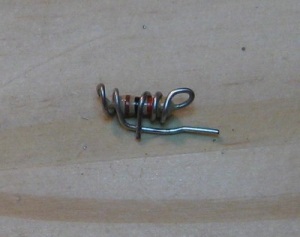

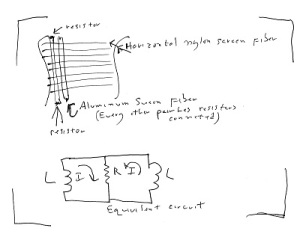
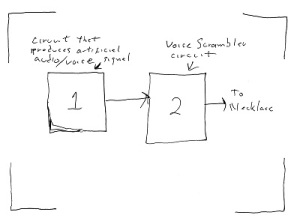
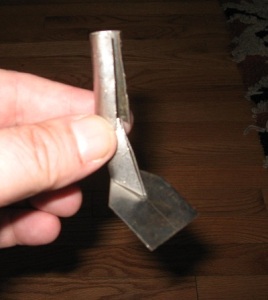


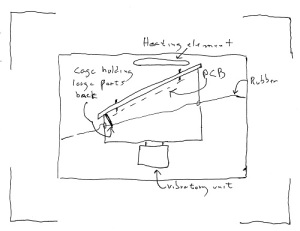






No comments:
Post a Comment